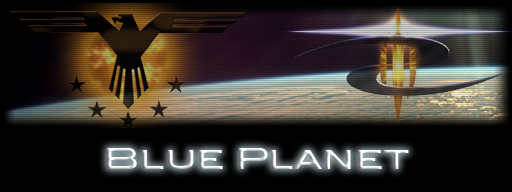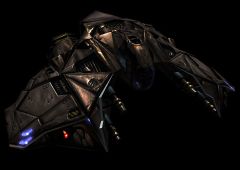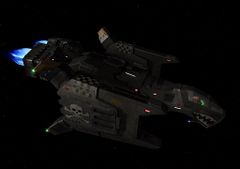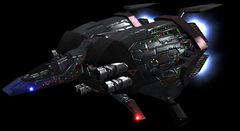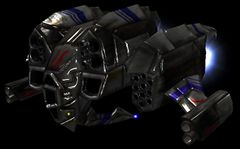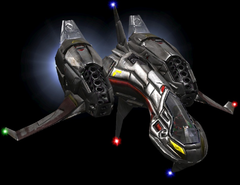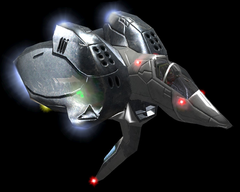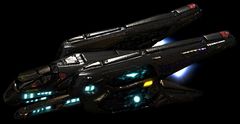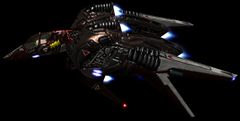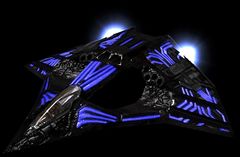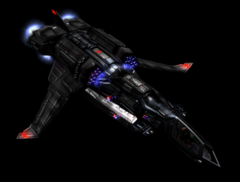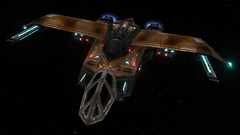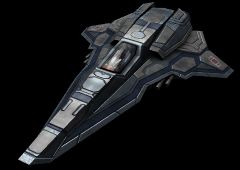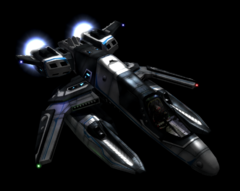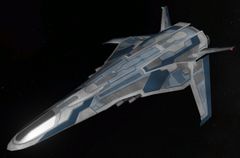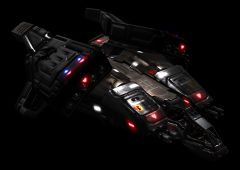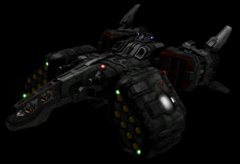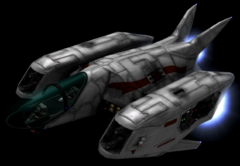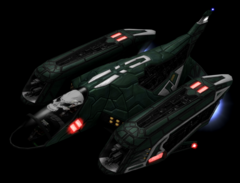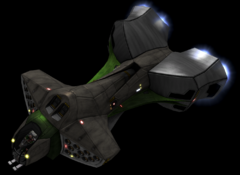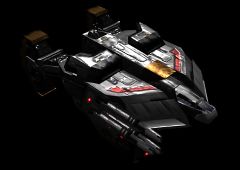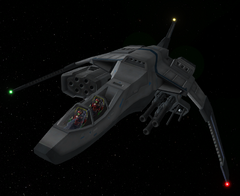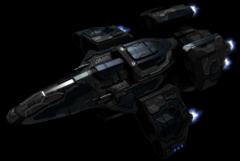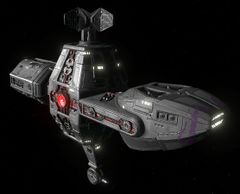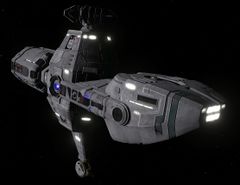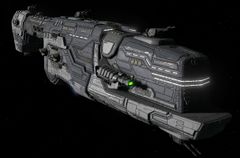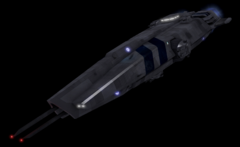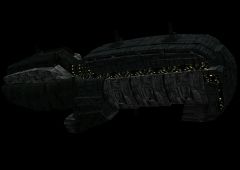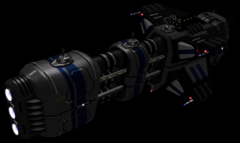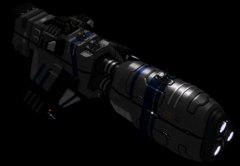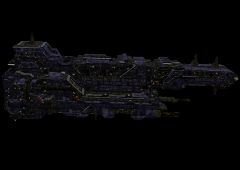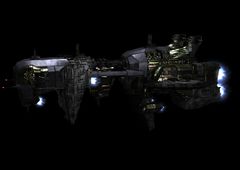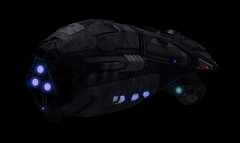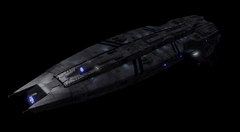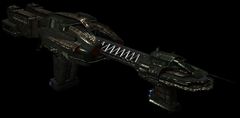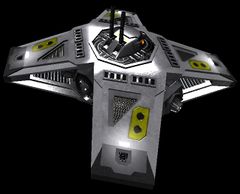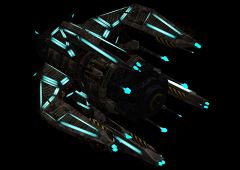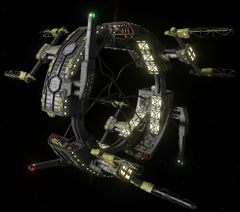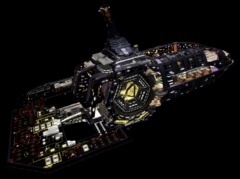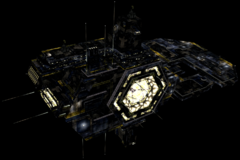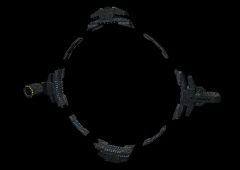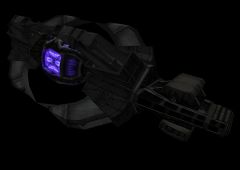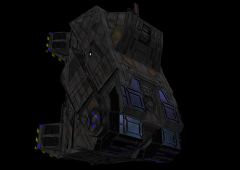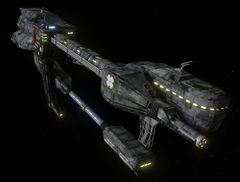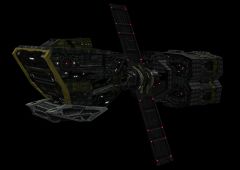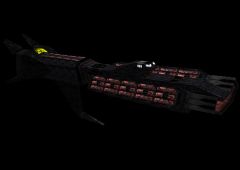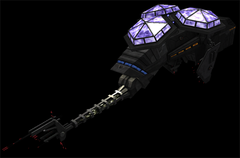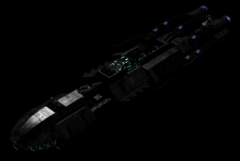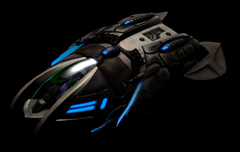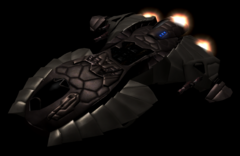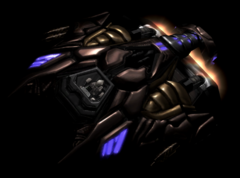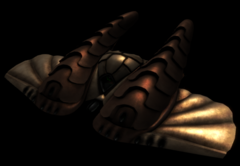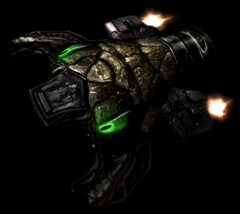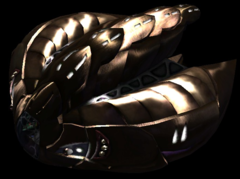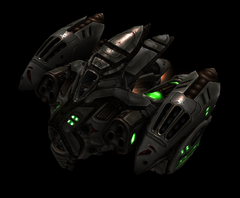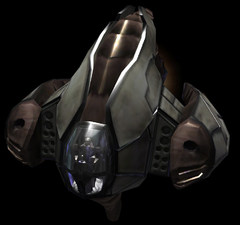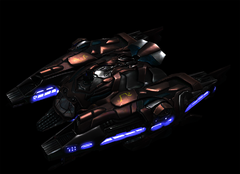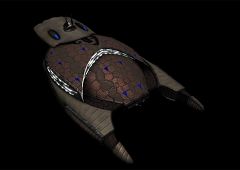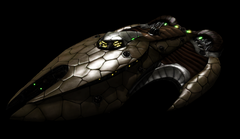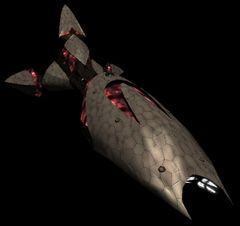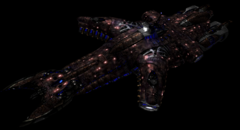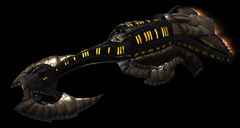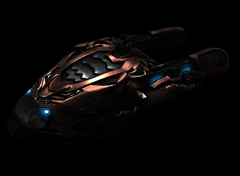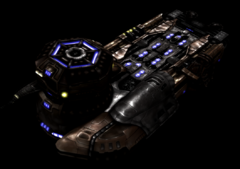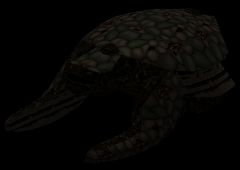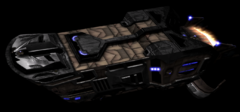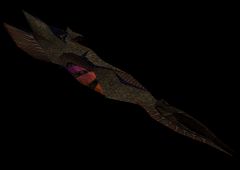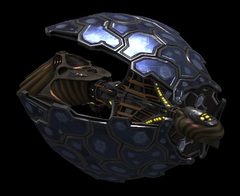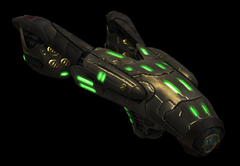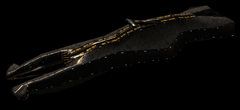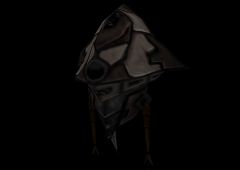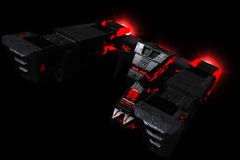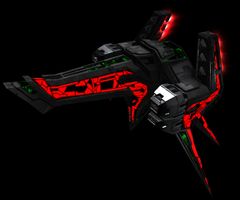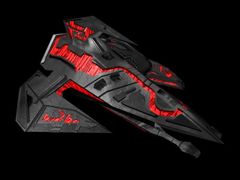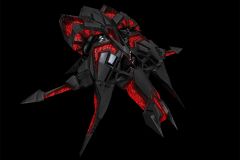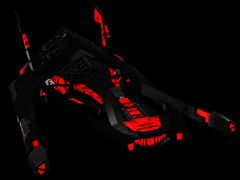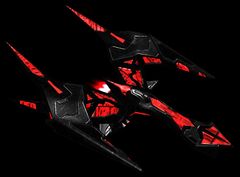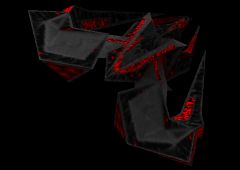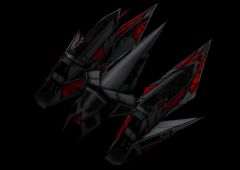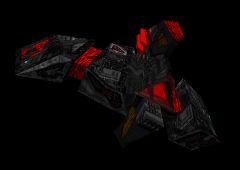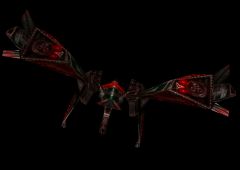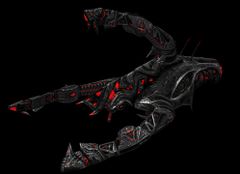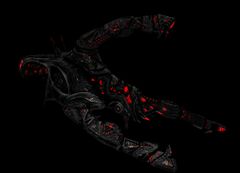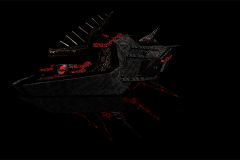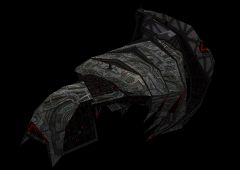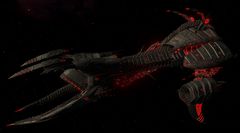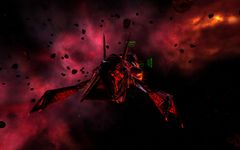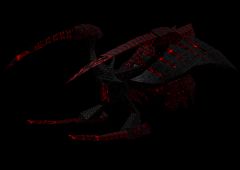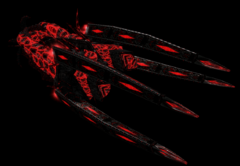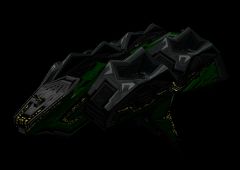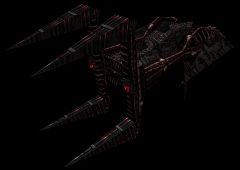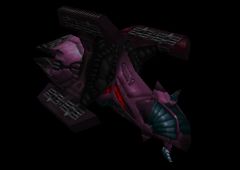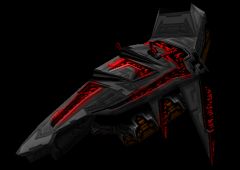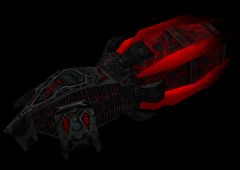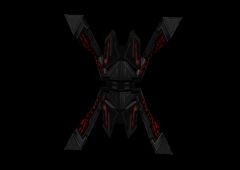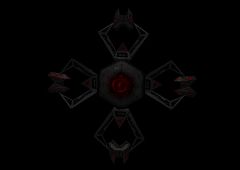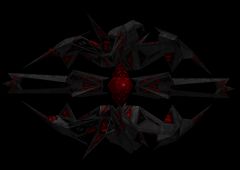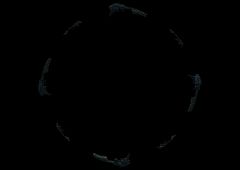Difference between revisions of "Blue Planet ships data"
m |
m (Updated Ravana image) |
||
| (One intermediate revision by one other user not shown) | |||
| Line 99: | Line 99: | ||
===[[GTF Kulas]]=== | ===[[GTF Kulas]]=== | ||
| − | [[Image: | + | [[Image:GTFKulas.png|left|240px]] |
The GTF Kulas was originally a civilian design popular with pirates and law enforcement agencies within GTVA systems. After the resolution of the Second Shivan Incursion, RNI Systems refurbished the design, replacing the old reactor with one of military grade. The result is a moderately powerful light fighter, notable for its excellent afterburner endurance - allowing it to cover large areas in pursuit of bombers. The GTVA purchased enormous numbers of Kulas to fill out escort squadrons. | The GTF Kulas was originally a civilian design popular with pirates and law enforcement agencies within GTVA systems. After the resolution of the Second Shivan Incursion, RNI Systems refurbished the design, replacing the old reactor with one of military grade. The result is a moderately powerful light fighter, notable for its excellent afterburner endurance - allowing it to cover large areas in pursuit of bombers. The GTVA purchased enormous numbers of Kulas to fill out escort squadrons. | ||
| Line 1,011: | Line 1,011: | ||
</pre> | </pre> | ||
===[[SD Ravana]]=== | ===[[SD Ravana]]=== | ||
| − | [[ | + | [[File:Ravanawiki.jpg|left|240px]] |
<pre style="white-space: pre-wrap; | <pre style="white-space: pre-wrap; | ||
white-space: -moz-pre-wrap; | white-space: -moz-pre-wrap; | ||
Latest revision as of 03:36, 31 July 2020
| The following information has not been confirmed by Volition and is therefore not canon for the FreeSpace universe. |
|---|
This page aims to be a one-stop shop for tech room entries and veteran comments relating to BP ships.
Back to Blue Planet Tech Room data.
Contents
- 1 GTVA Terran ships
- 2 GTVA Vasudan ships
- 3 Shivan ships
- 4 Other ships
GTVA Terran ships
GTVA Terran fighters
GTF Ulysses
A product of joint Terran-Vasudan design, the Ulysses is a Great War-era light space superiority fighter renowned for its maneuverability and slim target profile. It saw limited action during the Second Shivan Incursion, serving on front-line units with the Neo-Terran Front and as a combat evaluation fighter with the GTVA. The Ulysses remains in very limited production, but has been completely retired from front-line GTVA formations.
GTF Loki
The linchpin of GTI fighter forces during Rybak's Hades Rebellion was the Loki stealth fighter. Initially an invisible nightmare, the Loki lost its main tactical advantage when a weakness in its stealth systems was discovered. It was moved into the role of scout fighter during Reconstruction, but was often pressed into the dogfight and intercept role by the Neo-Terran Front, where it earned praise for its agility but struggled to compensate for its structural weakness. The Loki has not been produced since the NTF Rebellion, and most remaining spaceframes have been sold off.
GTF Hercules
The Hercules assault fighter was the crowning jewel of Allied fighter forces during the Great War, and it remained a favorite amongst pilots even after the introduction of its successor, the Hercules II. Many Hercules units were lost during the NTF rebellion. The Hercules has been pulled from front-line service, and production has been discontinued. Remaining spaceframes serve as targets or in security operations.
GTF Myrmidon
The Myrmidon fighter, designed by RNI Systems to fulfill an impossibly broad request from the Admiralty, is a space superiority fighter with problematic handling, the primary firepower of an assault craft, and three secondary banks of unusual design and limited capacity. It is gradually being phased out, but still serves as a line fighter, bomber escort, and battle group guardian across the Terran elements of the Alliance fleet. Some pilots achieve a particular affinity with this unusual craft, but in general its wide target profile has given it a reputation as a pilot-killer. Captured Neo-Terran Front pilots reported that the Myrmidon was respected for its firepower but considered too clumsy for its role.
GTF Perseus
The mainstay of the Terran fleet after the Second Incursion, the Perseus is produced on nearly every world in the Alliance and assigned to every destroyer in every battle group. Reassigned from intercept to multirole combatant after its sterling performance during the Second Incursion, the Perseus is cheap, flexible, and an excellent dogfighter and interceptor. In a pinch it can perform anti-subsystem strikes on warships with Stiletto II bombs. Even with the advent of next-generation fighters, the Perseus will remain in service for years to come.
GTF Hercules Mark II
The Hercules II assault fighter sacrifices some of its predecessor's cannon firepower for a boost in secondary capacity. The modernized, hybrid spaceframe offers enhanced ordnance bays and a sophisticated fire control computer. The Hercules II performed well during its OpEval period and, despite casualties during the Second Shivan Incursion, was judged a success in its assigned role attacking lightly defended targets and cruisers. However, the introduction of the Ares spaceframe, a modified Hercules II, has limited Hercules II deployment in the true heavy assault role. Hercules II fighters are used as skirmishers against lightly defended convoys, and as heavy missile pickets on escort missions.
GTF Erinyes
The Erinyes had barely entered its OpEval period when the Second Shivan incursion began. It served with SOC units and, later, elite line squadrons, where it gained a reputation for massive firepower but low sustainability. Mounting the UD-8 Kayser probability weapon, the Erinyes' eight gun banks and good secondary capability give it tremendous killing power. But its reactor cannot handle the strain of sustained fire, and its maneuverability leaves something to be desired. Although it proved effective at massacring most Shivan fighters, and went into wide-scale production during the Threat Exigency Initiative, it remains an oddly paradoxical design - an excellent killer but a limited fighter. As agility became more and more critical to fighter design, the complex Erinyes proved impossible to re-engineer. Although it remains in service with elite squadrons for heavy space superiority missions, it will soon be superceded by the next-generation GTF Nyx.
GTF Ares
The Ares was the result of a crash program to rebuild the Hercules Mark 2 as a heavily armored missile boat. Slower and clumsier than its base model, the Ares mounts depleted uranium armor plating over critical subsystems, molybdenum plates, and enhanced shields. It can carry sufficient Trebuchet missiles to disarm a light warship or fend off multiple bomber wings before rearming. The Ares entered service just as the Shivans stormed Capella, and what few units were available saved thousands of lives during escort missions. Despite a stormy production history, the Ares is now a front-line combatant, used in heavy assault missions, pop-up Trebuchet strikes, and critical defensive missions. Despite its usefulness as a missile platform, it cannot dogfight effectively, and must avoid interceptors at all costs.
GTF Pegasus
The low-visibility, sensor-stealthed Pegasus fighter is a recon platform above all else. Operated primarily by Special Operations Command, Pegasus pilots work in pairs or alone, cruising for long cold hours or days without making telltale subspace jumps. The onboard sensor systems are adequate to the recon task, but limited by the need to maintain EMCON. Even when they must make subspace transits, Pegasus jump drives are difficult to detect or vector. Pegasus pilots gathered critical information that helped suppress brush wars after the Second Incursion, and allegedly performed deniable assassination missions.
GTF Aurora
The Aurora is a heavy reconnaissance fighter designed to replace the Loki in its intended role of scouting, interception and space superiority. The Aurora is a swift fighter and carries several advanced avionics and sensor systems to assist in the gathering of information. However, the added equipment has produced a heavy hull, limiting the combat manoeuverability of the design. Aurora fighters are currently undergoing mission trials with the 14th Battlegroup in the Sol system.
GTF Kulas
The GTF Kulas was originally a civilian design popular with pirates and law enforcement agencies within GTVA systems. After the resolution of the Second Shivan Incursion, RNI Systems refurbished the design, replacing the old reactor with one of military grade. The result is a moderately powerful light fighter, notable for its excellent afterburner endurance - allowing it to cover large areas in pursuit of bombers. The GTVA purchased enormous numbers of Kulas to fill out escort squadrons.
GTF Atalanta
The Atalanta is the first of the Threat Exigency Initiative's Wave 2 fighters, true next-generation strike craft with extraordinarily capabilities. Produced in record time by the Alliance's first wholly classified procurement and design process - plagued by rumors of intrigue and mysterious 'red assets' - the Atalanta is an elegant, minimalist design wholly devoted to murdering other strike craft with very nearly Shivan flight characteristics. The original specifications of the Atalanta called for a multirole interceptor and space superiority fighter. Due to the United Earth Federation's fighter corps' successes, this variant has been field-modified to enhance its capabilities in the space-superiority role. These fighters remain rare in the Terran theatre, but they are likely to become a mainstay of Alliance forces in the near future.
GTF Nyx
A product of the second wave of Threat Exigency Initiative fighters, the advanced GTF Nyx is one of the newest GTVA heavy fighters, falling somewhere between multirole heavy assault/space superiority niche and the Vasudan concept of a space dominance fighter. The design was fast-tracked in 2385 as a response to increasing fighter losses to superior UEF fighter designs. A dedicated gunship killer, with heavy armour and firepower, this fighter has become the bane of many a UEF pilot. It marries the Erinyes' eight gun banks with the agility and versatility of the Perseus interceptor, producing a sterling design that has become a pilot favorite. Extraordinary cost, however, has slowed its planned deployment.
GTF Draco
Analysis of defensive actions during the Second Incursion, such as the evacuation of Third Fleet Headquarters in Capella, revealed systemic failures in defensive fighter coverage. Multi-axis attack by lightly escorted Shivan bombers demanded rapid redeployment across kilometers of space, and in terms of pure linear speed, no Terran fighter design was up to the challenge. When the Threat Exigency Initiative was launched, one of the first demands of the GTVA admiralty was for a new dedicated fighter design in the pure intercept role, a tactical niche left empty since the retirement of the GTF Valkyrie in 2361.
The result of a rare collaboration between Triton Dynamics and its longtime competitor Nankam Aeronautical, including subcontracts to Snapka-Flegel and Boone Thrusters, the Draco was accepted for combat evaluation trials a few weeks before the outbreak of the war in Sol, conducting peacekeeping and customs operations in the Terran periphery. Its stunning speed and fast recharge drive capacitors quickly made it a pilot favorite.
Evaluation did not complete in time for the departure of the 14th Battlegroup, and GTVA Command further held back its deployment to the Sol theater for fear that it would be easy prey for UEF point defenses and the heavier Kentauroi. While it remains a rare sight, these concerns were largely unfounded, and thanks to a doctrine of evasion and attack by pure speed, the Draco now enjoys one of the highest kill/casualty ratios of any Alliance strikecraft in the conflict. Although its light weapons suite - designed to engage Shivan bombers and intercept warheads - leaves it arguably undergunned when attacking heavier UEF strike craft, the Draco nonetheless exerts a powerful tactical presence, dictating terms of engagement and placing its opponents firmly on the defensive.
GTVA Terran bombers
GTB Zeus
The Zeus was a GTI tactical bomber, designed for light anti-shipping work and as a tactical missile platform. For nearly twelve years after the Second Incursion, the Zeus actually remained in production to serve as a stopgap Trebuchet delivery system, as well as in its historical role carrying light warheads like the Stiletto II. The Zeus now serves as a training target and has been largely removed from service.
GTB Medusa
The Medusa is an obsolete Great War-era bomber. It was used in an anti-shipping role by the Neo-Terran Front, but never met with any real success. GTVA pilots considered the Medusa an ineffective deathtrap.
GTB Artemis
Artemis bombers were not anticipated to be a success, but after a strong showing during the NTF rebellion, they now represent the majority of the GTVA's tactical strike ability. Maneuverable and cheap, the Artemis is able to deliver its payload rapidly. Tactical analysis suggested that bombers rarely survived prolonged engagement, so the Artemis' limited warhead capacity is considered non-problematic. Without defensive turrets, the Artemis is reliant on fighter escort, but it can dogfight if pressed. This behavior is strongly discouraged during pilot training, but because Artemis bombers are often deployed with inadequate escort, it frequently becomes necessary. The bomber's single primary bank is often fitted with a Maxim cannon for supplementary firepower.
GTB Artemis D.H.
A more maneuverable variant of the Artemis bomber, the Artemis DH has seen production alongside its white-skinned cousin. It is used in the same tactical role, targeting cruisers and corvettes.
GTB Boanerges
A controversial new heavy bomber at the time of the Second Shivan Incursion, the Boanerges proved a logistical dream but a mixed blessing tactically. Heavily shielded and with a large payload, the Boanerges eschewed defensive turrets as "of limited use." Bomber pilots did not react strongly to this decision, and although the Boanerges is at least capable in its role, it still divides pilots today. Good maneuverability allows the Boanerges some success in reaching its targets, but in spite of heavy armor cannot withstand defensive fire from warships or interceptors. It is an open question whether heavy bombers will remain tactically relevant. For the moment, the Boanerges' easy maintenance, cheap assembly, and long lifespan make it common in the heavy anti-shipping and anti-installation role.
GTB Ursa
Fifty years after the Great War, the Ursa bomber still serves the GTVA as an inflexible but powerful anti-shipping platform. With limited speed, the Ursa struggles to reach its targets, and in spite of heavy armor it cannot survive engagement with even a single interceptor. Its large target profile renders it vulnerable to flak and beam fire. Tactical doctrine calls for Ursa deployment against destroyers after their antifighter defenses are disarmed and their fighter compliment depleted. Designers today consider the Ursa a dead end, and strive to manufacture bombers with fighter-like maneuverability and speed.
GTB Rhea
The Rhea is Han-Ronald's next generation strike bomber. Its primary role was, at least in theory, to conduct precisions strikes against targets without the need for a dedicated escort wing. This tactic has been quietly discouraged by squadron leaders, and although the Rhea is generally considered a success, it now flies with escort like other bomber designs. Its unusual asymmetrical design is unpopular with pilots, but it appears to be a statistical success even amongst the historically casualty-prone bomber force.
GTB Gorgon
Next-generation GTVA fortress bomber. Designed to perform standoff attacks with Bifrost torpedos, launch local SSMs, and command flights of drone bombers. Survivability and return rate are primary design goals, so the class carries self-defense EMP charges, armor hardeners, and a sprint drive. BACKBREAKER integration provides the Gorgon with full AWACS capability.
GTVA Terran warships
GTC Cretheus
The Cretheus gunboat, officially a Fast Picket, is a small, cheap, agile escort with dedicated antifighter defenses, limited anti-warship ability, and a tortured design history. The prototype was fielded during the Second Incursion, intended as a cheap, numerous escort platform armed with eight Flak Turrets. But the first prototype was lost during its OpEval period in a classified operation on the fringes of the Capella system, and the findings of the loss investigation pointed to unacceptable vulnerability to hostile beam-armed warships. RNI designers protested that the ship was never meant to operate under such conditions, but lobbying by the Akheton Corporation, which hoped to push a variant Mentu design into the light escort role, managed to block the other prototypes from deployment to Capella where, ironically, they might have saved tens of thousands of lives lost to Shivan bombers. The spaceframe was brought back into consideration during the first wave of the Threat Exigency Initiative, but Morgan Technologies asked for it to be held back until it could be packaged with first new fire control systems, then provisions for their new pulse weapons, then improved flak magazine storage. The design entered mass production two years before the Reunion in a number of variants, but the Akheton Corporation again held back its deployment, and it is only now being cycled into the Sol theater where it is intended as a gunship deterrent and point defense picket.
GTC Fenris
The Fenris was never a successful warship design. Too lightly armored to withstand assault fighter attacks, unable to meaningfully engage other warships even after upgraded with beam weapons, and bogged down by inefficient reactors and an obsolete spaceframe, the Fenris is now used solely as a target or a patrol cruiser. Cramped quarters and an inflated crew count due to obsolete automation make posting to a Fenris into a punishment detail.
GTC Leviathan
Unlike its cousin the Fenris, with which it shares a spaceframe, the Leviathan remains in limited use in some battle groups as a destroyer defense picket. It is useless against modern warships, but its four Phalanx anti-fighter systems give it respectable deterrent ability. Painfully slow both in realspace and in terms of subspace agility, the Leviathan is a crude, inefficient, and largely obsolete warship.
GTC Aeolus
Although cruisers are now largely considered obsolete, the Aeolus was so successful at fending off fighters and bombers during the collapse of Capella that production lines were re-opened. New manufacturing techniques brought costs down, and today, Aeolus-class 'cruisers' serve in the role of tactical gunboat, escorting corvettes and destroyers and anchoring rapid-response Jump Five teams. They are ineffective against warship but truly nightmares to any nearby fighters.
GTC Hyperion
Oldest of the next-generation GTVA warships, the Hyperion cruiser represents the Alliance's best shot at a new niche for the aging cruiser hull — a scout, skirmisher, and anti-fighter platform that can conduct reconnaissance by fire, draw off bomber wings, and engage larger ships from range with its Thorn Lance light beams.
With corvettes dominating the the main line combatant role, cruisers must be deployed - and built - more carefully. Hyperion captains train to respond to their many predators, including heavy assault wings and beam-armed warships.
After Capella, the Threat Exigency Initiative launched a push for new military technology and doctrine. At the center would be a next generation of warships, more agile, sophisticated, and survivable than their ancestors: capable of sliding around Shivan concentrations and applying force to gaps and weaknesses.
They would also be more expensive. Unfortunately, the Terran economy had just flown into a supernova.
GTVA High Command issued a requirement for a next-generation cruiser that could serve as an escort, skirmisher, and screen element. It would have the anti-fighter prowess of the Aeolus, a highly capable subspace drive, next-generation power systems, and electronic warfare capabilities. All this was true, but it was also a smokescreen.
In truth, the Hyperion-class cruiser was an attempt to shake down next-generation systems...and next-generation procurement. The Admiralty took a torch to the connections between the officer corps and Alliance contractors, then rebuilt the procurement system with brutalist efficiency. Careers flared up, burnt out, and spiraled off into nothing around the Hyperion as teams fought to get their systems on-board.
Economic sequestration placed the Hyperion in danger of cancellation, and suddenly project teams began withdrawing, trying to avoid tying their technology to a failed warship. This left the baffled hull designers with no choice but to build a ship without knowing what equipment it would carry.
The team drew on experience with the Deimos corvette to build the ship from the reactor out, selecting a simple hull form and flexible power grid. This allows the Hyperion to easily mount new systems. Even the forward beam cannons are trivial to replace if destroyed, since the emitters are isolated from the plasma cores.
The first block of Hyperions served as a testbed for meson reactors, pulse weapons, and next-generation beams. Although successful as anti-fighter pickets and reasonably affordable, they didn't hit the mark for subspace agility or anti-ship firepower. The class is still rolling through a series of block upgrades, expanding electronic warfare capabilities and installing survivability packages for the main weapons.
The Hyperion is notorious for the so-called 'bad quench' failure mode of its meson reactors, which severely limits the crew's chances of survival in the event of a hull loss.
GTCv Deimos
The Deimos corvette is to the Terran fleet today what the Fenris was during the Great War. Built in vast quantities, the Deimos now serves as the myrmidon of the GTVA, employing its adequate beam firepower and excellent anti-fighter abilities in its role as destroyer escort, line corvette, patrol craft, and centerpiece of corvette battle teams. It is due to be augmented, but not replaced, by the new Bellerophon and Chimera corvettes. Molybdenum armor and Vasudan reactors give the Deimos excellent survivability and the ability to jump early and often. Deimos corvettes will continue to be produced for decades to come.
Deimos corvettes seem to be easily retrofitable, as some corvettes in War in Heaven sport Terran Turrets II or STerPulses.
GTCv Chimera
The Chimera corvette is the archetypical next-generation warship, a flying beam cannon with a superb subspace drive and power grid. Designed to kill destroyers and Sathanas juggernauts, the Chimera mimics the shock jump tactics of the Second Incursion, drawing on the new ISN BACKBREAKER strategic communications and sensor fusion standard to plot jumps and find targets.
In combat, the Chimera points at the biggest ship around and fires until there's nothing left to shoot at. Three Aurora Wake main beams provide unsurpassed killing power for the hull size. Clouds of vaporized coolant gave the corvette the unflattering nickname 'the bong'. Thermal management is a major concern, and the corvette could easily destroy itself with unwise tactics, but the ship's power grid handles well.
Defensively, the Chimera counts on next-generation active armor and an array of pulse and beam weapons to screen it from bombers. Like all next-generation corvettes, the Chimera must be ready to serve as a destroyer escort.
Chimera production is ramping up, with the perhaps-ambitious goal of matching every Deimos battleteam with a single Chimera by the end of the century. With the exception of the beam reactors, the class came in well under budget.
Of all the TEI's next-generation warships, the Chimera had the smoothest development. Data from the Hyperion class allowed designers to choose simple priorities very early: light hull, huge guns, good heat sinks, good drive, all other concerns secondary. The power grid actually overshot the target, providing the class with excess capabilities that could be exploited by a Block 2 upgrade.
Unfortunately for Chimera crews, no amount of excess power has yet provided a solution for the corvette's abominable living conditions. A software error stocked the first example of the class, Pilum, with thousands of identical pre-cooked meal pouches, each one broccoli and tofu - leading to the much-beloved story of the Cooks' Mutiny. Live on a flying gun, the saying goes, and you get treated like a bullet.
GTCv Bellerophon
The Bellerophon heavy corvette is a logical variant of the Chimera, mounting an Ice Queen destroyer-grade beam in place of one of its little sister's Aurora Wakes. The Bellerophon fills the exact same niche as the Chimera, but it brings more force to the battlespace.
Advocates of the Diomedes corvette fought hard to kill the Bellerophon, claiming it was redundant with the Chimera. But VEGADEX data suggested that marginal gains in speed-of-kill on hard targets like destroyers and juggernauts could create vital strategic opportunities. A difference in seconds could win victory. The Admiralty upheld the design requirement.
A special team directly under High Command expanded the hull into a triangular shape, hollowed out a space for a self-contained Ice Queen and thermal systems, and packed the new hull volume with command electronics and sensors so that the Bellerophon could serve as a corvette leader. When operating in a pack with other corvettes, the Bellerophon can integrate sensor data to generate fast and accurate navigational solutions. The Bellerophon actually contains more classified equipment per hull volume than any other main-line Alliance warship.
Some thermal issues plagued the first two spaceframes, leading to the installation of a hot-metal heat sink on the ventral hull.
To the dismay of Fleet crew, the Bellerophon shares a common life support space with the Chimera.
GTCv Diomedes
Conceptualized early in the Threat Exigency Initiative warship program, the Diomedes-class strike corvette was shaped by the necessities of two worlds: the tactical realities of the post-Capella battlefield and the political turmoil of a Fleet in crisis.
GTVA designers conceived the Chimera and Bellerophon-class corvettes hand in hand with new doctrines of of massive force application. These designs were intentionally overspecialized to neutralize Shivan destroyers and juggernauts with beam alpha strikes. Strike craft support, aggressive subspace maneuvering, and sheer shock would, it was argued, allow the Chimera and Bellerophon to outrun their own design weaknesses.
But more conservative factions of the GTVA military agitated for a less specialized next-generation design, a successor to and improvement upon the still-young Deimos corvette. Politically, they needed a warship that would fit the operational profile of line as well as elite units, but they also offered compelling tactical reasoning. Agile, aggressive combatants lacked the staying power for prolonged defensive operations at hardpoints, nodes, or convoys. A cheaper, more all-round design could supplement Deimos production with a powerful corvette leader or a supporting element to cover the flanks of destroyers or sister corvettes. Other camps in the Fleet added their own requirements: the addition of a fighterbay would open up possibilities as an SOC platform, or in the independent strike role through organic escorts or bombers. Missile launchers and magazines would allow for selectable munition loads.
The notional Diomedes became a rallying point for design schools who had been pushed out of the main thrust of Threat Exigency Initiative work. The design went forward, but these competing requirements should have produced a catastrophic compromise.
Instead, GTVA designers produced a fascinating warship, one whose weaknesses are addressed by carefully counterpointed strengths. Armed with four Bull Frost next-generation anti-warship beams in a pair of twinned lateral batteries, the Diomedes relies on its startling agility to bring its firepower to bear. Designed to engage targets abeam, the class rewards flanking tactics and circling engagements against larger hostiles and aggressive action against multiple lighter opponents. Considerable sacrifices were made to operationalize the ship's fighterbay, but the potency of an on-board interceptor or bomber unit justified the cost, particularly in the areas of point defense and counter-air. The Diomedes' weapons suite also includes light pulse cannons and a pair of missile launchers capable of anti-fighter or anti-warship fire. Unburdened by massive beam weapons, her reactors permit a modestly rapid jump cycle and excellent ESM and active armor capabilities.
Even as the GTVA has cracked down on its own patronage system, dissolving the lines of influence that connected warship designers and commanders to particular schools, the Diomedes has acquired a reputation for scrappy flexibility and solitary pluck. Neglected by formal doctrine on the eve of the UEF-GTVA conflict except as a general 'flank escort' and 'fast response expedient', Diomedes captains drilled their own tactics and built a quiet professional community.
The ongoing conflict has found the Diomedes thrown into the fire, often alone, often undersupported, acting on sketchy intelligence to provide decisive force at key moments. Casualties among the Diomedes class exceed that of any other next-generation warship, but GTVA commanders have taken note of the design's successes, and of the discipline and capability of her crews. Once seen as the ugly duckling of the TEI warship line, the Diomedes now finds itself in strategic and tactical demand
GTVA Terran capital ships
GTD Orion
The magnificent Orion destroyer was the GTVA's heaviest line combatant in the Second Incursion, complimenting the Hecate-class carriers. With the new Erebus class entering service, the Orion has at last found a worthy successor, and its five-decade career is nearing an end. Some Orions remain in service, including the storied GTD Carthage, now a Combat Evaluation Destroyer with modified jump drives.
See also: GTD Cathage, Sanctuary
GTD Hecate
The Hecate carrier was designed for rapid, efficient fighter operations rather than direct combat. The Second Shivan Incursion proved the value of this strategy, but also highlighted its flaws. Whenever Hecate-class destroyers found themselves in direct combat with hostile warships, they failed to perform. The Hecate now makes up the bulk of the GTVA's destroyer fleet, and, in line with current fighter-heavy strategic doctrine, serves as a rear-area base for strike craft operations. Hecate destroyers never enter combat without their battlegroups. Superior fighter capacity and an excellent flight deck make the Hecate an extraordinarily flexible power projection system, and this ability is at the center of the GTVA's planning for future Shivan threats.
GTD Titan
The Titan-class destroyer/strike carrier bases more fightercraft than any other Alliance vessel. Armed with a mighty triple array of 'Ice Queen' spinal beams, a battery of pulse weapons, and Supernova meson torpedoes, the Titan serves as a companion to the Erebus-class line destroyer.
In the event of a new Shivan incursion, the Titan will hold in support of its Erebus partner, deploying its fighter wings to generate and exploit openings. In this respect it resembles a larger Hecate-class. But the Titan also shares the Erebus' excellent subspace agility, and its main beams make it a capable shock attacker. Developing doctrine suggests that the Titan will serve either as a firefighter, leaping onto and erasing Shivan breakthroughs, or as a force lever to punch through vital targets.
Titan development proceeded under the codename COLD WEDGE. The first attempt drew on design principles from the Massive Mjolnir and Supercarrer design camps, but it failed when Triton Dynamics studies suggested the hull's ammunition stores would be catastrophically vulnerable. A second attempt began under a Vasudan project leader, but internal politics caused great offense, and only a hasty diplomatic intervention by Aya McCarthy retained the Vasudan team as a reactor lead.
The third iteration of the Titan design drew heavily on the Ravana destroyer, creating an eerie reputation around the team offices. The hull coalesced around a hangar module, a main beam spine, and a sophisticated engineering section for the drive and reactors. BACKBREAKER and SCORPION PROPHET combat management and network software coordinate the ship's systems, with added facilities for precise attacks out of subspace jumps. The Titan's power systems and ammunition stores are highly distributed to enhance resilience. Multiple emitter arrays give the Titan excellent long-range sensor and command capability. Because the Titan's role requires fewer sudden power transfers than the Erebus, its power grid is more conventional and less integrated, closely following the pattern established by the Hatshepsut.
Considerable dispute rages over the best use of the Titan's tactical presence. The class could serve as a supercarrier, an attrition sniper that leaps between hot spots and picks off primary targets, a floating reserve, or the hammer in a fix-and-fire team with the Erebus.
A long waiting list has developed for Titan postings, in part because of career opportunities for fighter officers, in part because of the type's excellent quarters. Conspiracy theorists often debate whether a module exists to replace the hangar bay with a long-term habitat so the Titan could serve as a deep-space ark.
See also: GTD Temeraire, GTD Imperieuse
GTD Erebus
The Erebus-class destroyer. Humanity's sharpest sword. Primary force concentration asset in the Threat Exigency Initiative's doctrine of effect warfare. A triumph of achievement in the face of adversity: both economic and existential.
The mission of the Erebus is to enter a tactical situation and successfully resolve it. No matter the threat, the Erebus is designed to deploy tactical intelligence, subspace agility, weapons fire, its onboard air wing, battle group command, and strategic connectivity in a unified plan to degrade and destroy the foe. Tactically, the Erebus depends on nothing.
Implicitly, the Erebus is meant to duel - and win against - small groups of Sathanas juggernauts.
Armed with a WINTER KING long-range spinal beam cannon, an ICE QUEEN coaxial main beam, an array of anti-warship beams, a battery of massive pulse weapons, a comprehensive CIWS close-defense suite, selectable-load SARISSA-M1 torpedo launchers with subspace attack capability, and an active armor suite tougher than the Colossus, the Erebus is a killer. Her weapons layout suits her role as a door-kicker, plunging into formations of smaller warships, but she can also outrange a Sathanas juggernaut for as long as necessary to defang its weapons.
But a modern Alliance admiral asks about the weapons last. The platform's truly revolutionary capability lies with her tactical systems.
The Erebus' heart is an integrated power system fed by redundant meson reactors. Her overengineered grid can safely surge combat systems ranging from sensors to main beam weapons by orders of magnitude. Slurry heat sinks and generous thermal tolerances permit tactical overloads in emergency situations. Buttressed electronic countermeasures managed by a Vasudan SCORPION PROPHET combat net degrade the effectiveness of all incoming fire, from main warship beams through aspect-seeking warheads down to the very basic primary weapons of strike craft.
That same power system feeds a revolutionary sprint drive, a multi-core subspace engine capable of rapid subspace transits. Erebus' sensor/navigation fusion capability can retask classical and subspace arrays between tactical and navigational needs. A cutting-edge navigational system with a dedicated n-space active battery array cuts down calculation times and, some allege, permits at least tenuous plotting of multiple chained jumps.
Communications systems built to the Alliance's BACKBREAKER standard provide common operational capability in the face of most jamming, but the Erebus also boasts a command theater for battle group coordination in non-permissive comm environments. The Erebus' informational weapons systems are built to partner with a Titan-class destroyer, incorporating the Titan's air wing and battle group into force awareness. When multiple Erebus-class destroyers operate in the same theater, BACKBREAKER can designate a group leader or coordinate a flat, decentralized operational schedule which intelligently distributes tasks across the Erebus battle groups. Future upgrades may integrate AWACS capability directly into the destroyer.
The Erebus' primary design tradeoffs lie in her fusion drive, air wing, and logistics. As a line combatant, the Erebus carries few strike craft. She is as fast as a Sathanas, but no faster, relying on her subspace drive to keep the range. And while tactically independent, the Erebus requires more logistical tail than many next-generation warships.
Cataclysm gave birth to Erebus. The death throes of the GTVA Colossus killed more than thirty thousand officers and crew — and an entire philosophy of warship design. The detonation of the Capella star wiped out not only a densely populated system, but an entire concept of strategic action. No more would the GTVA depend on monumental centerpiece combatants, designed to draw the enemy into a single set piece engagement and score a knockout blow.
The disaster left GTVA fleet doctrine in ashes. But the Alliance arranged its remaining assets, profiled available intelligence, and set to work. Next time apocalypse came knocking, they'd be ready.
The Threat Exigency Initiative was a crash-response program to the Shivan threat glimpsed at Capella. Fed by GTVI/SOC, the unflappable Space War College, and the grueling VEGADEX exercise series (which matched Alliance fleets against simulated Shivan opponents), the TEI program set out a series of short and long-term goals for Alliance military survival.
In the short run, the successful elements of the Capella-era military were enhanced. Deimos corvettes took over the old cruiser role. AWACS/TAG coordination saw renewed focus. Stealth fighters and pop-up missile doctrine became core elements of fleet training. The Hecate-class destroyer held onto its niche as mobile fleet base, providing logistics and carrier capability to the corvettes and strike craft that would in turn hold back swarms of Shivan bombers. Cheap new designs were requisitioned. This element proceeded smoothly: Capella had boiled most existing doctrinal disputes and contractor interests away.
But it would take something radically new to challenge an armada of more than eighty Sathanas juggernauts. And here there was room for conflict. Some factions pushed for an end to the destroyer class, moving to a doctrine of corvettes and light carriers. Others wanted supercarriers, or 'juggernaut destroyers', massive flying beam cannons with limited defensive capability.
Ultimately, a verdict was achieved. Supercarrier and Massive Mjolnir advocates would get an answer in the Titan destroyer. But something more was needed.
Wherever Alliance destroyers in the Second Incursion had been given enough escort to hold, enough intelligence to plan sorties, and enough support for their air wings, they had achieved victory. Wherever Alliance destroyers had been committed in haste, without the ability to either outrun or outfight possible threats, they had met disaster.
The Alliance needed a smart, agile, flexible line combatant: as tough as an Orion, as well-equipped to support battle groups as a Hecate, as terrifyingly quick to reposition as a Ravana, and able to both locate and exploit weakness in the enemy disposition.
Development began under the codename NIMBLE BASTARD, then moved to Admiral Armanjani's task force as LONGSWORD. The project foundered for several years under the curse of 'concurrency', a plan to build the hull and power systems, then gradually install new technologies as they were developed. But Armanjani successfully fought to delay both the Titan and Erebus projects until meson technology was fully mature. Soaring development costs were in part defrayed by quiet investments from the Vasudan Medjai, and the actual unit cost of the Erebus class remained within budget.
The Erebus emerged as a dream ship, poised on the edge of nightmare. Crammed with cutting-edge systems, the class has yet to prove its reliability in main combat. Some critics assert the switch from flak to pulse weapons will leave the vessel vulnerable to bombers. Other believe the sprint drive is a game of Russian roulette.
Examples of the class include Atreus, Orestes, Agamemnon, and Menelaus. Atreus, under Admiral Steele, has seen the most extensive shaking-down, but a minor scandal has developed in the Admiralty concerning Steele's refusal to obey politically desirable test parameters.
If the Erebus-class performs as expected, production will continue at full pace until the GTVA is satisfied multiple next-generation battle groups can rapidly respond to any new incursion. The Erebus will remain the spearhead of effect warfare for the foreseeable future...or until the doctrine fails.
See also: GTD Orestes, GTD Atreus
GTVA Colossus
Thirty thousand of the GTVA's finest, Terran and Vasudan alike, died aboard the GTVA Colossus when it was destroyed by a single Sathanas juggernaught in Capella. Twenty years of effort, along with all the pride and propaganda bound up in the massive warship, were lost in a mere twenty seconds. After this tragedy, GTVA warship design steered away from massive superships and towards more flexible advanced destroyers. In spite of frequent rumours, no plans to build a fleet of Colossus warships have ever been suggested.
GTVA Terran support ships
GTSG Alastor Bravo
GTSG Alastor sentry gun platforms can be dropped by warships to cover a retreat, or they can be used to strengthen firepower around strategic locations. While Alastors alone cannot hold a position against more than a few fighters, complementing them with a warship and several wings of fighters presents an exemplary defense against all but the most determined foes. The Bravo variant uses twin missile lanchers drawing from an ammunition storage derived from the Hygeia support ship.
GTSG Mjolnir
The Mjolnir beam cannon is a fantastically powerful but tactically inflexible weapons system commonly used for node defense. Mounting one of the most potent anti-warship attack systems in the GTVA arsenal, it is a threat to any warship. Critical vulnerability to fighter attack necessitates the deployment of escorts or other sentry guns. Dozens of Mjolnir weapons systems have been manufactured and are kept ready to form node blockades. Several are already deployed at the site of the collapsed Capella node in Vega.
GTI Ganymede
The unsung cornerstone of Terran military might, the Ganymede ring is an integrated repair, resupply, and refit facility with onboard machine shops, electronics manufactories, and foundries. Each ring can service five warships simultaneously, including extension-of-service refits and block upgrades. The TEI upgrade to the Ganymede’s adapter protocols was one of the most logistically and politically painful episodes in GTVA military history, with two flag officers falling to graft charges.
GTI Arcadia
The GTI Arcadia is a multi-purpose installation that has served the Terran fleet since the days of the Great War. Almost every major star system is host to at least one Arcadia, which is often used as a center for trade and communications. Home to scores of small ships, including repair vessels, fighters, and transports, an Arcadia installation is always a hub of intrasystem and interstellar traffic. An Arcadia is not an easy target for hostile forces, as it combines the firepower of over 20 weapon turrets with the ability to launch up to ten wings of fighters from its fighterbay. In the post-Capella era, Arcadias have assumed the role of system evacuation hubs, where civilian traffic rallies to take on refugees in case of Shivan attack.
GTI Asteria
The GTI Asteria was originally designed as a lighter, forward-deployed sibling to the Arcadia. With nine docking points and a fighterbay, the station is well fitted to serve as a hub for local trade. After the Joint Tactical Platform was canceled in favor of the Anemoi logistics ship, military exigency pushed the Asteria forward as a supply outpost in contested areas. With 24 turrets, including modern anti-fighter beams, the Asteria's self-defense is adequate, but its primary function is as a logistical node.
Alliance Jump Gate
The Alliance Jump Gate employs Knossos technology to connect Delta Serpentis to Sol along the severed jump node. Requiring eight years of planning and a decade to build, the Sol Jump Gate is the largest project undertaken by the GTVA since the Colossus.
TC-Meson Bomb
Developed at the Hideki Institute in Vega, the meson bomb is a strategic antimatter weapon of appalling power. Exploiting staged meson decay to unleash energies locally approaching the Big Bang environment, these weapons are temperamental, unbelievably expensive, and vital to defense doctrine. Only large clusters of meson weapons can reliably collapse subspace nodes, preventing Shivan outbreaks. The long firing sequences and relatively short range of strategic meson weapons make them unsuited for tactical applications except in the field of demolition, since enemy forces can outmaneuver or even disable the weapon. But tactical variants of this technology have now entered the GTVA arsenal.
GTT Elysium
More than half a century old and still in production, the GTT Elysium transport is the definitive interstellar utility craft. The Elysium lineage has radiated into a dizzying number of variants, from engineering support craft to covert blockade runners.
With only a single defensive turret and minimal armor, the Elysium should, one post-Capella swarm combatant refit notwithstanding, never be deployed in combat. But its small logistical footprint, fuel economy, and low downtime often put it in harm's way. The Elysium's single greatest asset may be its robust and flexible docking system.
GTM Hippocrates
The Hippocrates medical ship is built in multiple, easily isolated compartments in case of disease outbreak. These vessels are amongst the GTVA's most important, traveling from system to system to provide disaster relief and specialized medical facilities. The Hippocrates can carry thousands of patients, and as such, the Block 2 upgrade provided it with some defense: anti-fighter weapons and even a light beam cannon. However, only the most desperate of circumstances would necessitate their use.
GTSC Faustus
The Faustus science cruiser is a tactical disaster and strategic asset of unparalleled worth. Terran-Vasudan shield systems were designed aboard a Faustus during the Great War, and when the Alliance discovered the Knossos portal 32 years later, the same class of science cruisers carried Mina Hargrove’s team to their fateful work. Easily destroyed by even a single enemy fighter, the true worth of the Faustus lies in its onboard information and laboratory systems, including neural-net computers capable of agnostic response to a broad range of problems. Some see the Alliance’s failure to develop a tactical science ship as a major failure. Others point to the constant race for grant money as an explanation for the longevity of the Faustus, since no one can afford a new ship. Whatever the case, an end to the current economic recession might see the design of a new lead science ship. Until then, the Faustus will continue to be upgraded and repurposed by those in search of truth.
GTG Zephyrus
Zephyrus gas miners harvest and transport deuterium for Alliance fusion drives. These vessels are vital strategic assets, but extensive armor or defensive systems would only slow them down. The new Anemoi-class logistics ship handles fueling in combat theaters, while the Zephyrus continues to serve as the lungs of the fleet. Wherever a secure gas giant may be found, pilots can expect Zephyrus operations. A small but outspoken faction in GTVA fleet doctrine, the Convoy Cabal, insists that the installation of a few modern point defense systems would allow the Zephyrus to contribute to convoy anti-warhead defense.
GTA Charybdis
The Charybdis Advanced Warning and Control System is a fragile but extraordinarily useful piece of technology. Capable of calculating and rapidly relaying precise subspace jump coordinates, it enable GTVA fighters and bombers to approach their targets at optimal range. It can also perform blanket communications jamming, selectively block aspect lock on itself or friendly warships, or grant itself or nearby vessels limited stealth. OpEval equipment permits it to generate EMP blasts or to guide subspace missile strikes to their targets.
GTL Anemoi
Logistics vessels are the newest class of support vessels commissioned by the GTVA. These mammoth ships serve as an all-around support ship, combining freight hauling capabilities with field repair stations and medical facilities. They are an indispensable asset to long-range battlegroups that are expected to undergo long-term operations far from friendly outposts. Two of these vessels have been deployed with the Sol Expeditionary Force, the GTL Solace and the GTL Fortune.
GTVA Vasudan ships
GTVA Vasudan fighters
GVF Seth
The Seth is a Great War-vintage Vasudan strike craft designed to both protect and destroy bombers. It meets this requirement in particularly Vasudan fashion, slow to keep pace with bombers but equipped with a superb afterburner to chase them. The Seth's incredible Mekhu-Sahr plasma power plant gives it design longevity, leading to significant Vasudan smugness about the value of putting good power systems above all other concerns. Pilots point to the Seth's slim target profile when closing or retreating as key to mastering the craft. Although the Seth's fore-mounted sensors are extremely vulnerable to beam fire, Vasudan pilots take pride in resolving engagements without aspect lock. As a decades-old favorite, the Seth has seen continued production in the maze that is Vasudan private industry. The Set Mace is a popular modern variant.
GVF Horus
Terran pilots often advance two complaints against Vasudan fighters. Their gun placement is poor, and they often cannot survive in a non-permissive environment. Vasudan aces reply that what is most important is the ability to avoid that threat environment in the first place. The Horus light interceptor lines up with both the complaint and the rejoinder. A nimble high-speed attacker, the Horus fares poorly when being shot at but offers skilled pilots a wide range of maneuvering options. At the time of the ship's design, Vasudan tactical philosophy prized the ability to penetrate and disrupt enemy groups, since placing the enemy on the defensive was seen as the key step to victory. The Horus excels in this role, and with modifications to use modern long-range missiles, it can serve as a sniper and skirmisher. Like most Vasudan ships, the Horus remains in production in some capacity, built by Sentences with industrial capability. The Horus-Ur is an example of modern builds.
GVF Thoth
A frail little beetle of a dogfighter, the Thoth was once a dreaded sight for Terran pilots. Nimble and armed for only a single mission, the Thoth could prey on Terran fighters and bombers, setting the terms of the engagement and performing quick slashing attacks. In this light the design's widely spaced guns make sense, because repeated pinpoint hits are less important than consistency over multiple attacks. As the lethality of warship point defenses evolved, however, the Thoth's huntings grounds dwindled. The stigma of the Hammer of Light stained the design, but it remained in service as a line space superiority fighter. Terran pilots hoping to master the Thoth must understand Vasudan fighter doctrine, which leverages Vasudan advantages in energy efficiency to feed a more flexible, hit-and-fade fighting style. Prolonged engagements are death, and superb spatial awareness is a must. Vasudan fighters do not forgive error. The Thoth's production history is far more exclusive than most other Great War era designs, and only names tied to the Sahr Corporation participate in Thoth assembly today. The Asten Thoth is the solitary modern variant.
GVF Serapis
The post-Capella era has seen an explosion of Vasudan technological, cultural, and economic power. It often reassures Terran observers to know that the Vasudans are also capable of grand and systematic mistakes. After Operation Templar, Vasudan doctrine called for two lines of new fighters to be deployed. Agile, sophisticated light craft would disrupt and outmaneuver enemy formations, while heavy-hitting assault craft would provide killing power. The Pa-anmu Admiralty championed this doctrine, in part because it would satisfy a wide range of industrial concerns, helping stabilize trade and strengthening the Ambassador to Caravans. The Ambassador would use that strength against the Emperor's military advisors, opening opportunities for Pa-anmu's allies. Designed as an affordably high-tech interceptor and dogfighter to cover roles filled by the Horus and Thoth, the Serapis boasted revolutionary controls and incredible agility. The opportunities for artistic expression were intoxicating, and before anyone could outmaneuver the Pa-anmu Admiralty, the Serapis had become an icon of Vasudan progress and prowess.
The Serapis sacrificed armor and shielding to hit these design targets, and it quickly became apparent that the rise of anti-fighter beam systems threatened the Serapis mission. The fighter was relabeled an interceptor, a feat of linguistic engineering which Pa-anmu hoped would keep pilots away from warship fire envelopes. But the Serapis lacked the linear speed for that role, and was inevitably deployed as a space superiority fighter. Pilots able to rapidly juggle multiple threats while toggling power systems can win stunning performance from the Serapis, but the craft simply needs more survivability. During the Second Incursion the Serapis produced both a number of aces and a large number of casualties. A hasty retrofit to mount the Maxim cannon allowed the Serapis to serve as an anti-warship skirmisher, giving it a new tactical niche. In some respects the Serapis became the lightest heavy assault fighter ever built. Peacetime production in both corporate and private capacity has filled Vasudan space with Serapis fighters, but many have received survivability packages. The current Imperial Vasudan Navy standard is the Isi-Serapis, but the Medjai has already replaced the Serapis with the next-generation Serekh Taa space dominance fighter, and the IVN has terminated procurement.
GVF Tauret
The Tauret is a heavy assault fighter whose wildfire success ended an Admiral's career. When the Pa-anmu doctrine called for one light and one heavy fighter to spearhead the Vasudan fleet, engineers and artisans machinated furiously to win the light fighter design. Inevitably, not everyone made it. Worse yet, the Tauret project was given an insultingly generous line of credit and an Ambassador to facilitate political needs. Since lack of constraint invites excess, and excess is death, the team set out to hobble themselves. First, they decided to build a tribute to the Apsu-Hek, a foul-tempered ambush predator from Vasuda Prime. This popular emblem would keep them humble and alert. Second, they sought out Terran funding and engineering talent to avoid drawing on their baited credit line. Successfully tapping Terran strengths while still producing a uniquely Vasudan design would display adaptability and vigor.
Serious problems with the Tauret's power grid nearly sank the project, but the team rose to the occasion, tapping RNI's experts and incorporating Terran solutions. The team settled on a wide, thin spaceframe with excellent thermal characteristics and trivial shield solutions. The problem of volume was solved, again, with humility, using artistic fold algorithms to efficiently pack systems.
Although the Tauret does suffer power issues, its reactor feeds six gun mounts, a massive arsenal of missiles, and respectable shields and armor. Initial reactions were negative, in part because the Tauret's design made it extremely frustrating to service. But telemetry from the nebula theater established that the Serapis' whirlwind agility couldn't keep it from the scythe, while Tauret squadrons steamrolled Shivan forces with obdurate ferocity. The team paid off their debts, Admiral Pa-anmu graciously stepped aside to pursue the arts, and the Tauret quietly become the heart of Vasudan air wings.
In modern times the Tauret has been supplemented by the Maa-kheru siege fighter, but it remains a vital strength of the IVN.
GVF Ptah
Akheton's Ptah stealth reconnaissance craft sprang from the same joint product as the Pegasus stealth fighter. Although the hull configuration and stealth systems are divergent, the craft's final performance is comparable to the Pegasus, with superb agility and carefully baffled emanations. The Vasudan design team paid less attention to target profile and visibility than the Pegasus team, preferring to work with a tested configuration, and as a result the Ptah is far easier to maintain and has nearly twice the operational up-time and sortie rate. Ptah missions provided vital data in the Alliance's attack on the first Sathanas juggernaut.
Ptah postings and deployments have become politically controversial since Capella. The IVN and Medjai both maintain Ptah wings, nominally for strategic reconnaissance. Several IVN admirals have been accused of deploying stealth fighters as political instruments. Conversely, whispers suggest the honorable and heroic Medjai use Ptah sorties to eavesdrop and monitor loyalties. "The Ptahs know" is an idiom suggesting both that a secret has been breached and that the breach may be proper - or improper, depending on the delivery.
GTVA Vasudan bombers
GVB Sekhmet
The Vasudans lost their homeworld to the Shivans. Nothing can heal that wound. But the Vasudans are a pragmatic people, resilient to loss, and when Operation Templar shattered the Hammer of Light, Mekhu Enterprises found something to take back - a Shivan bomber design adapted by the Hammer of Light. As if haunted by its origins, the Sekhmet maintains a ferocious reputation. Mekhu produced a spectacularly expensive juggernaut of a bomber, heavily armed and plated in molybdenum, a pocket warship stitched into a compact frame. The Sekhmet's power plant and drive actually make it capable of dogfighting at par with many fighters. Many of the design techniques used in the Sekhmet remain highly classified, and the spaceframe is still exclusively produced by Vasudan military corporations. No other bomber in the Alliance arsenal can strike in such a wide range of tactical environments.
Although once rare, the Vasudan economic boom has enabled widescale Sekhmet production, fulfilling Khonsu's requirement for organic fleetwide anti-destroyer capability. Training for a Sekhmet post is intense, ritualistic, and exclusive. Rumors of Hammer rituals plague the corps. In spite of this taint, the Sekhmet's raw power inspired the design philosophy behind modern Vasudan superfighters such as the Serekh Taa, Maa-kheru, and Abatos.
GVB Bakha
The first modern strike bomber to enter the Alliance arsenal, the Bakha is an economic triumph. Built around two baffled Akh-12 engines, ancestors of the Ptah's stealth drive, the Bakha's elegant spaceframe won the hearts of hangar crews across the Vasudan navy. Slightly tougher than its Terran counterpart, the Artemis, the Bakha also boasts two separate primary gun banks. Defensive dogfighting is an integral part of Bakha pilot training. Perhaps most importantly, the Bakha passed through design and qualification in record time, and its production line is extremely economical. This makes the Bakha a natural partner to the hideously expensive Sekhmet.
The Bakha came to life almost wholly through nepotism and favor-trading. Fortunately, all the relatives involved were competent professionals with the best interests of the Vasudan people in mind. By the time of the NTF rebellion, shipyards over the grave of Vasuda Prime had turned out more than six thousand Bakhas. As the rebellion began to target Vasudan civilians, Bakha squadrons scrambled to protect Vasudan interests from NTF warships. One famous squadron, Atinmerit's 808th, violated standing orders and conducted pre-emptive attacks without fighter escort against NTF rallying points. This story provided the inspiration for the smash hit "This Price I Pay".
Like many products of the Pa-anmu Admiralty, the Bakha suffers when faced with layered anti-fighter defenses. Bakha squadrons developed SEAD tactics using Trebuchet and Stiletto missiles. Although the Bakha could not carry the Maxim cannon during the Second Incursion, Serapis fighters provided improvised support.
The single greatest failure the Bakha ever suffered related to the Helios warhead. The software hastily distributed for the Helios capability accidentally treated the weapon as a primary gun, not a guided warhead. Technicians aboard the Psamtik had to write their own code to get the Helios operational in time for the attack on the SJ Sathanas.
Modern marks of the Bakha fly under the designation Apis Bakha.
GVB Osiris
The obsolete Osiris was the primary Vasudan fleet bomber during the Great War. It performed well at the time, but as warships got tougher, the Osiris simply couldn't carry the payload required to score kills. Pulled from front-line order of battle, the Osiris remains in service with Vasudan system defense forces, armed with anti-subsystem munitions for police and customs work. Although obsolete Terran spacecraft are generally used as targets or sold off, the post-sorrow Vasudans have a tradition of private ship maintenance that keeps old designs in circulation. A spacecraft, they argue, is an obscenely expensive and intricate piece of technology, and it must be appreciated for its practical and historical worth.
In recent months a surprising number of Osiris spaceframes have been purchased by Terran military contractors. Speculation suggests that the Terran defense establishment, frustrated with attrition in the strike bomber corps, has decided to look elsewhere for inspiration. The twin-turreted Osiris may represent performance data of interest. Interestingly, the terms of purchase neglected the usual stipulation for Terran environment and control refits.
GTVA Vasudan warships
GVC Aten
In the post-Capella era, the Aten has been reclassified from cruiser to heavy picket. A senescent design, fragile and agonizingly undergunned, the Aten killed thousands of Vasudan officers and crew during the Second Incursion by simple inability to defend itself. Swarms of Shivan Basilisk fighters proved a particular menace, since their missiles were too small for intercept, but the Aten's lack of anti-warship beams meant it was no match for Shivan cruisers.
The Vasudan preoccupation with history and lineage is a source of real friction in fleet doctrine. The Vasudans, loathe to waste functional spacecraft, actually continue to maintain the Aten as a convoy escort. The hull has been upgraded to the Aten-Re standard, with enhanced active armor, hardened subsystems, a pair of modern KHAFRA BURN energy flak guns, a capacitor system feeding an Akheton pulse cannon, and improved TAG awareness for fire support. The pulse cannon provides interdiction and area denial capability against small groups of strike craft. Expanded automation collapses crew requirements to 250, leaving much of the hull uninhabited. These pickets serve as convoy motherships, packing components, fuel, and medical systems to manage any en-route emergencies.
The next-generation Vasudan cruiser, the GVC Akhenaten, fills the fast strike and skirmisher requirement that the Aten never met.
GVC Mentu
The Mentu should've been the Vasudan Navy's modern strike cruiser, built from the keel up to mount a pair of Mkh/Akh 121b anti-warship beams. A typically superb powerplant, including acoustic baffles engineered to rumble at pleasant frequencies, would keep the Mentu charging along at good speed even while operating the weapons. Intelligence and publicity documents from the Mentu's development make it clear that the design was meant to showcase Vasudan anti-warship beams.
But the Mentu was another ironic casualty of its ancestor's vices. The Aten cruiser was so cripplingly unsuited to front-line action that it would be reassigned as a convoy escort and rear-area picket once the Mentu joined the fleet. But leading members of the Kames Admiralty, who saw the future in direct action by modern destroyers, refused to accept the absence of an anti-fighter cruiser on the front lines. Destroyers could take out enemy warships, with fire support from the new corvettes. Someone had to shoot down all the bombers, and it certainly wouldn't be the fighter corps.
Through a series of manipulations that encompassed finance, social life, and art, the Kames Admiralty misdirected the Mentu's engineers about the heat requirements of the Mkh/Akh 121b. The result was a superb strike cruiser -- without the heatsinks required to operate its own main weapons for more than a few shots. The 121b performed too well to be rebuilt. Less than six months before its OpEval period, the Mentu was redesigned as a fast escort with its main beams downgraded to Phalanx anti-fighter beams.
The officers responsible escaped prosecution, as they had simply arranged to be misunderstood. Their malfeasance may have saved lives. The Mentu served in the Second Incursion as a fast escort cruiser, swatting warheads and bombers with an excellent CIWS and interdiction arsenal. Tough, long-lasting, and well under budget, the Mentu worked well with the Sobek corvette in a sword-shield pair. Early in the war, Mentu captains developed the infamous Against Apsu maneuver, flying the GVC Somtus and GVC Mycerinus belly-to-belly to take advantage of their weapons and armor layout in an engagement against the NTF.
Ever since, Mentu captains take pride in the command to roll ship. The modern Mentu-Ra uses slurry coolant, finally granting it the heat capacity to mount anti-warship beams. It is the principle cruiser of the IVN. Older Mentu variants still serve as escorts, armed with pulse cannons and energy flak.
GVCv Sobek
The Sobek is a superb ship-to-ship combatant, a brutal sword of a corvette that specializes in direct attacks against hostile warships up to destroyer size.
Military historians mark the Sobek as the beginning of the Second Incursion warship design era. After the destruction of Vasuda Prime by the SD Lucifer, the Admiralties issued a requirement for a new class of warship, a heavy destroyer escort that would be able to destroy any Shivan cruiser in single combat and make an accounting of itself against Shivan destroyers. The first Sobek design was long and slim, built around a pair of railgun-assisted flux cannon, a Vasudan torpedo weapon. The Sobek's designers also built a meticulous power grid in anticipation of future shield capabilities. Terran observers classified the ship as a corvette.
Warship-scale shielding failed to materialize, but beam technology matured, and the Sobek's reactor and hull profile proved a good match for the Mkh/Akh 182. This early beam cannon suffered range and accuracy issues. It pumped more matter than cruiser-scale beams, but lacked the huge plasma core clamps and bottle controls of destroyer-scale systems. Test fires tended to cavitate and fail into a spectacular but ineffective blowtorch.
Unlike Terran designers, however, Vasudan procurement occasionally makes concurrency work. Mekhu solved the blowtorch issue with the Mkh/Akh 183, which allowed the magnetic bottle to swivel, sacrificing accuracy for effect. Two of these beam weapons replaced the flux cannons in the Sobek's spine, operationalizing the Alliance's first corvette. Doctrine deploys the Sobek as a killer, focusing down single targets with the forward beams. In main fleet engagements, Sobeks seek out and prosecute any threat to friendly destroyers.
During the Second Incursion, the Sobek-class Dashor escorted the GTD Carthage during initial containment in Gamma Draconis. During the botched attack on the SD Ravana, the Khenmu outmaneuvered the Shivan destroyer, surviving to provide vital fire support. The Tatenen made first contact with the Sathanas, transmitting telemetry on the juggernaut's forward beam weapons even as it died to them. The Renenet and Thebes engaged Shivan forces during the campaign to destroy the Sathanas, taking out the SD Beleth and countless fighter wings. Again and again, Sobek corvettes proved their worth, even under impossible conditions.
The modern Sobek-Ra features enhanced active armor and EW capabilities, as well as a reactor refit and a total point defense upgrade to improve the Sobek's survivability against strike craft attack. The IVN deploys the Sobek-Ra as its mainstay warship alongside the Aaru-class heavy corvette.
GTVA Vasudan capital ships
GVD Typhon
The Typhon-class destroyer is a veteran of the Great War, an old soldier still doing the Emperor's work.
The Vasudans saw the Terran-Vasudan War primarily as a conflict of symbols and will. Very few Vasudan leaders believed that a civilized, spacefaring people could commit planetary-scale murder. However, the Vasudans saw the aggressive, paranoid Terrans as simplistic and unstable, and they sought to communicate by violence in terms the Terrans would respect. Vasudan tactics prized disorientation, violence of action, and psychological effect, up to and including suicide tactics.
The Typhon-class destroyer was built to incarnate Vasudan pride, a purposeful echo of the Terran Orion. Built in formidable secrecy, the original Typhon featured anti-fighter missiles, heavy plasma weapons, and a staggering hangar capacity. At the Vega engagement, a Typhon-class destroyer closed with and destroyed the GTD Eisenhower, while the Typhon's air wing decimated the Terran Fourth Fleet. The victory was both symbolically and strategically critical.
During late Reconstruction, the booming Vasudan economy fueled a new fleet, and Vasudan designers faced a choice. The Terrans had elected to build the new Hecate-class, a destroyer that could serve as a fleet carrier. The old Orions would be retained as line combatants. In Terran analysis, future engagements would be resolved primarily by air wings, with corvettes providing escort and artillery support. Destroyers would remain in safety.
Vasudan analysis from the Kames Admiralty placed more weight on decisive action by destroyers on the front lines. A requirement was placed for a modern destroyer to serve as a spearhead, and the Typhon, suffering power grid issues with its new beam weapons, was re-roled as a fleet carrier and second-line destroyer. The role of symbolic supership would be inherited by another design.
Modern doctrine keeps the Typhon as a garrison destroyer, watching over the buzz of Vasudan trade and intrigue. A number of Typhons also serve as arsenal ships, armored with heavy ship-to-ship torpedoes.
GVD Hatshepsut
The Hatshepsut-class destroyer is a flying fortress, one of the finest capital warships ever designed by the Alliance. With an aggressive, backswept prow, a gleaming palace superstructure, and a thunderous fusion drive array, the Hatshepsut looks as good as she fights.
The Hatshepsut was born from the Kames Admiralty's decision to focus the fleet on decisive action against hostile destroyers. The Hatshepsut would mount modern beam weapons, missile silos, and a cutting-edge CIWS grid of flak weapons and anti-fighter beams. She would carry fewer fighters than the Typhon, but still maintain a strong air wing. Her command and informational systems would help Sobek-class corvettes select and prioritize targets. The design requirement was delivered in a series of exemplary Conversations, balancing the appeal of the Hatshepsut project against the prestige and history of rehabilitating the Typhon. As a result, the Hatshepsut team performed solemnly and correctly, avoiding some of the excessive overspecialization typical of excited Vasudans.
One major stumbling block was the ship's hull form. Early designs produced a long-neck, squat-based spaceframe. Designers agreed that the lead destroyer class of the Vasudan Navy could not look like it was about to be beheaded at the altar, so a number of sensor and command systems were moved to an arrowhead bow structure, improving resolution at a slight cost in latency.
During the NTF Rebellion, Hatshepsut-class destroyers leapt into front line combat, jumping from battle to battle and engaging NTF forces with only light escort. The golden ships became icons of Vasudan hope and targets of vendetta for the NTF. The type's formidable flak screen proved an incredible deterrent to fighter attack, and aggressive maneuvering covered for some blind spots in her turret coverage. Hatshepsut captains successfully used the ship's dorsal 255a anti-destroyer beams in circling and topsiding maneuvers, but the Hatshepsut's most fearsome reputation came from tactics against cruisers. Warships such as the Psamtik would safe their main beams, divert the power to subspace drive recharge, and close to destroy NTF vessels with anti-fighter beams, flak, and salvos of fusion mortars. The tactic harmed NTF morale, since it was clear the destroyers were more concerned with getting to the next fight than anything else.
The Psamtik was lost to the second Sathanas juggernaut in a risky deployment, but overall the Hatshepsut-class performed superbly. Production continues to this today, and the latest Hatshepsut Amaru features modern pulse weapons, extended flak range, enhanced command awareness under BACKBREAKER, expanded torpedo magazines with long-range anti-warship capability and anti-fighter interdiction, and slurry heatsinks. The Hatshepsut serves as an elegant front-line combatant alongside modern heavy warships such as the iKhemu-Sek.
GTVA Vasudan support ships
GVT Isis
The Vasudans love hotrods. Nothing says it better than the Isis, a common tugboat, shuttle, repair ship, and light transport - which is also the deadliest commando ferry in the Alliance inventory. Armed with a pair of Mekhu HL-7 close defense weapons and powered by the beloved Akh-4 powerplant, the Isis can insert boarding parties or repair teams even in live combat. The Terran arm of the fleet has quietly purchased a number of Isis transports, and the Vasudans habitually up-gun them for use as tactical gunboats. The Isis remains in wide production. The design's only notable weakness is its limited payload.
PVFr Ma'at
The dowdy Ma'at dates back to Vasudan commerce in the 14 Year War, where it trundled massive cargo containers from system to system. The advent of shields neutered the Ma'at's defensive armament, but the real blow to the design was the Bes' propellant efficiency, which gave it a huge marginal advantage over the Ma'at on the same routes. Today, Ma'at freighters fly civilian runs, serviced by a cooperative of Vasudan artisans who produce upgrades and replacement parts at rates cheap enough to offset the Ma'at's operating costs. The famous Vasudan Ambassador Thot-hartis favored a Ma'at for hauling her extensive collection of diplomatically useful art, relics, and conversation pieces.
GVFr Bes
The beetle-backed Bes is the avatar of Vasudan Reconstruction. Commissioned twelve years after the end of the Great War, the Bes is a weapon of peace, admired both for its sleek aesthetic and its incredible propellant efficiency. The Bes hit the Vasudan shipping market like a snort of black sand. It could just keep moving and moving, slashing operating costs and commodity prices. It helped propel an economic boom that flowered into a new Vasudan golden age. Although Emperor Khonsu II is often credited for the design, he only intervened to resolve a dispute that had kept the engine snarled in production, the victim of a grudge that spiraled off the McCarthy Affair. In this respect his wisdom was surpassing. Today the Bes swarms trade lanes, cheerfully keeping up the flow of commerce. Vasudan attitudes towards objects are complex, and the Bes seems to carry an aura of awe and fear, as if it has built up too much success and must someday be rebalanced. Bes crews traditionally grow desert flowers in the condenser spaces. Pilots should note that the Bes is a frail target, with limited survivability against heavy assault craft - a tragic weakness during the NTF rebellion and post-Capella violence. However, its two turrets provide a capable addition to convoy warhead defense.
GVFr Satis
The Satis is a Great War-era freighter originally built for wartime self-defense. Armed with five plasma turrets, it could pose a serious threat to unshielded fighters, freeing up strike craft for offensive action. The rise of fighter shielding killed the Satis' original role, leaving it stranded as an economically inefficient freighter. But the Satis remains effective at warhead intercept, so it's often salted into convoy groups as a self-defense supplement. Vasudan Tactical Command has explored upgunning the Satis for light fire support.
GVG Anuket
A curious hybrid, the GVG Anuket serves the Vasudan fleet as a gas miner, fleet tender, and sophisticated science ship. As a miner it harvests deuterium from gas giants, weathering harsh electromagnetic environments to feed the fleet's thirst. As a tender, the Anuket is a single-solution refinery, converting raw materials directly into usable fuel. During Vasudan operations in the Second Incursion's nebular theater, the Anuket was refitted with a powerful sensor suite, including subspace tracking equipment. Onboard laboratories and hot rooms helped Vasudan scientists study the supernova remnant. In the years since Capella, the Anuket's mission creep has expanded, and a number of task modules fitted inside the tanker's cavernous holds now enable the hull to serve as a lab ship, listening post, medical transport, and limited electronic warfare platform. The huge sprawl of onboard mission software has created concerns about security flaws.
The Anuket has no meaningful self-defense capability beyond a single Crow Lash flak gun, but it can contribute to warhead intercept with light CIWS. The ship's snowballing mission capabilities led to Terran complaints that pilots would have no idea whether to treat an Anuket as a tactical asset or a bomb.
The new Tawaret logistics ship has similar refining capabilities to the Anuket, but it is specifically a military asset and does not serve in a commercial role.
GVA Setekh
The Setekh Advanced Warning and Control System is a vital sensor and communications asset in Vasudan battle groups. It's also an acrimonious political flashpoint. The Terran Charybdis AWACS is cheaper, more compliant with GTVA operational standards, more secure, and better-defended. The Setekh's only real advantages lie in its compartmentalized hull design, which saves it from small fighter weapons, and its superior passive sensors. Yet the IVN insists on manufacturing and deploying the Setekh, insisting it is more suitable for Vasudan purposes.
During post-Capella political tensions, Terran admirals saw this is an intentional snub and a maneuver to deny contracts to Terran manufacturers. Accusations of economic warfare met with an angry response, and today the issue remains sore. In the meantime the Setekh has been upgraded to modern standards, providing the full range of AWACS services -- precision jump navigation for friendlies, aspect lock jamming, ECCM, interception and decryption, and limited defensive stealth. Whether the Vasudans have integrated SSM spotting capability remains classified. Terran pilots refer to this vessel as the Steak.
GVS Nephthys
Mekhu licensed the Triton Dynamics magnetic-stasis matter library system for the Nephthys support ship, which provides field rearmament to Vasudan craft. Loaded with ordnance and a powerful drive, the Nephthys is extraordinarily dangerous to fly.
Next-generation Vasudan fighters can allegedly manufacture their own ordnance and regenerate damaged systems in the field. Some analysts suggest that this is a myth, as the IVN has continued to maintain and upgrade the Nephthys. The latest block is stealthy and extremely quick. It is possible that onboard sustain systems are limited, or that the IVN simply wants the support ship available as an option for its older craft.
GVL Tawaret
The GVL Tawaret is an enormous Vasudan logistics vessel, comparable to the Anemoi. The Tawaret, however, doubles as a tanker capable of collecting gas and processing it for fuel to the fleet. As such, the Vasudan logistics ship lacks medical bays, and due to the fuel processing facilities, is susceptible to devastating internal explosions should it be fired upon.
GVSG Edjo
For fifty years running, Vasudan strategists have been trying to wean the Alliance off its addiction to deep-space supply depots. Depots were a major feature of Great War logistics, and a combination of institutional inertia and dependability keeps them in the logistical chain, despite their vulnerability. Even the Shivans exhibited depot behavior. But the post-Vasuda Imperium wants no part of anything that can't pick itself up and run.
One of the most obvious and passive-aggressive elements of this movement is the Vasudans' continued inability to build a decent sentry gun. When the Alliance requested that the Vasudan Navy upgrade the Ankh, they produced the Edjo, a substandard sentry gun by any measure. Although sentry guns are sometimes deployed by warships as close-defense options, the Vasudans seem content to use the ancient Ankh in this role.
Since Capella, the Terran military has moved towards more mobile logistics. A next-generation sentry weapon is definitely in production, but the IVN treats it as a tactical asset and refuses to share.
Shivan ships
Shivan fighters
SF Manticore
NEM.NOW MANTICORE Shivan space superiority and intercept fighter. Extremely frail. Clearly an optimum favoring environments in which linear speed permits situation control, agility is an adequate defense, and numbers help swamp enemy processing. Standoff tactics and heavier strike craft promote Manticore emanation, as do modes of attack with long run-up. Pilot integration is limited, suggesting that the organism's onboard reaction time and processing is adequate to the task. Introns favor hot swarm, cold swarm, berserker, and assassin. No standoff or bruiser introns detected. Scrambler, judas, and chain introns are present but not highly selected for.
SF Basilisk
NEM.NOW BASILISK Shivan heavy assault fighter. Limited agility and heavy shielding. Sensor layout and armament suggest an effect-scale optimum favoring attacks against lightly defended targets, with little consideration for self-defense against other fighters. The Basilisk appears to be a behavior for applying maximal force to vulnerable gaps. Tactics that favor point assets, without escort or disruption to break up incoming wings, will promote Basilisk emanation. Pilot integration is limited, suggesting minimal throughput required to optimize performance. All specimens have excellent range and endurance. Introns suggest Basilisks could manifest heavier warheads, standoff attack capabilities, or cold swarm behavior. Some specimens imply stealth or camouflage introns.
SF Dragon
NEM.NOW DRAGON Shivan elite agility fighter. Engages Allied strike craft using radical maneuvers across multiple degrees of freedom, to fearsome effect. Lightly armed and ineffective against larger craft. We hypothesize the Dragon emerges from a response heuristic favoring sophistication and local effect, without concern for difficulty of procurement. Because the Dragon is rarely encountered, we suspect it is somehow costly or consequential to procure. We believe that Allied tactics focused on groups of effective strike craft will cause Dragon emanation. Pilot organism integration is nearly total. Distinctions are arbitrary. Introns suggest that groups of Dragons may develop a number of swarm behaviors, including enhanced individual capability as swarm size degrades, i.e. hot swarm, or reduced individual capability as swarm size degrades, i.e. cold swarm. The berserker intron is not commonly encountered in Dragon specimens. Assassin introns may be present but results are inconclusive.
SF Mara
NEM.NOW MARA Shivan space superiority fighter. A strikingly balanced optimum between scale, effect, and sophistication in environments where pure maneuver is an asymmetrical advantage. Teleonomic analysis of the Mara design dates it to an era of behaviors fairly late in the projected conflict with the Ancients, so it is perhaps no surprise that the design seems pre-adapted. We have much better data on the Mara than most other design emanations, which makes it a point of enhanced investigation. The Mara appears to be promoted by enemy tactical sophistication. Its flexibility allows it to perform in the space superiority, escort, and heavy assault roles. We are concerned that the design may represent a bottleneck bypass into a new set of optimae. Pilot integration is moderate. Introns are extremely diverse, suggesting long lineage. Hot swarm, berserker, banshee, and standoff appear most probable.
SF Aeshma
NEM.NOW AESHMA Shivan assault fighter. Performs in the same niche as the Basilisk, but with reduced effect. This emanation was not present in the Lucifer fleet that destroyed the Ancients, but its presence in the nebula does suggest lineage from the same conflict. Effective only in swarm attacks against light targets. Statistical modeling suggests this emanation is moving towards extinction. Pilot integration is surprisingly high, given the simplicity of flight behavior. Much of the connectivity appears specialized for signals analysis and mathematical transformation. Possible relic behavior from a past role, perhaps as a Nagari amplifier? Introns strongly favor chain.
SF Astaroth
NEM.NOW ASTAROTH Shivan space superiority and intercept fighter. Agile but frail, the Astaroth depends on its slim target profile and confusing behavior. We believe the Astaroth represents a scale optimum in environments where noise and disorientation produce effect. Promotion factors are unclear, although we suspect the same factors that drive Manticore manifestation may operate. The curious possibility exists that the Astaroth also represents a kind of meta-noise, jamming attempts to infer Shivan procurement and deployment behavior. Pilot integration is extreme. Introns favor cold swarm behavior, with very limited hot swarm presence.
Shivan bombers
SB Taurvi
NEM.NOW TAURVI Shivan strike bomber. An apparent compromise between the Nahema and Nephilim types, the Taurvi appears to be a scale optimum, with limited sophistication and effect. High bomber casualties appear to promote Taurvi emanation. Pilot integration is limited. Introns favor hot swarm, chain, banshee, scrambler, and blink.
SB Nahema
NEM.NOW NAHEMA Shivan fighter-bomber and cause of significant consternation. Like the Mara, the Nahema appears to be a traversal design, pushing through a phase space bottleneck into a new array of optimae. Although superficially an effect-sophistication optima, with excellent performance, the Nahema also appeared in tremendous numbers, accounting for a major fraction of Allied casualties during the Second Incursion. We must conclude that it is also promoted by sophistication. Pilot integration is significant. Nahema pilots are unusually deficient in organs 7F202 and ivHQI. Introns favor hot swarm, berserker, assassin, standoff, and bruiser.
SB Nephilim
NEM.NOW NEPHILIM Shivan heavy bomber. Heavily shielded and armored warhead bus. Plainly an effect optimum, with limited sophistication and scale. Warship-heavy tactics with limited escort promote Nephilim emanation, as do large groups of lightly defended targets. The design appears to balance payload against chance of successful delivery. Pilot integration is extreme. We have no hypothesis: perhaps exaptive. Introns favor twin, scalar, scrambler, and blink. Primary weapons may approach or exceed the Kayser benchmark.
SB Seraphim
NEM.NOW SERAPHIM Shivan superheavy bomber. We believe the Seraphim is a scale-effect optimum, with limited sophistication. It employs brute force to steamroll its way to objectives, carrying massive payloads. Heavy warship tactics appear to promote Seraphim emanation, as does the destruction of Shivan capital ships. Pilot integration is extreme, perhaps due to sensory demands. The design's superficial similarity to the Manticore appears to be confounded by ESM capabilities in the limbs. Introns favor berserker, assassin, standoff, bruiser, and chain.
Shivan warships
SC Cain
NEM.NOW CAIN Shivan light cruiser. A Great War-era cruiser that manifested during the Second Incursion with a single cruiser-grade beam weapon, the Cain represents a baseline for Shivan tactical capabilities. Missile launchers and a CIWS beam make the Cain a respectable threat to fighter attack, but it is clearly a scale optimization for environments that reward the presence of multiple light warships. Promoters include large numbers of small Allied warships or small numbers of large Allied warships. Cain crews cycle through an erratic series of behavioral epochs that appear statistically similar to the dynamics of an eight-body system. Ecosystem violence correlates in an exact negative relationship. Most Cains host a macroorganism of indeterminate origin and considerable size which moves erratically through a space forward of the ship's stern. Feed-forward always occurs, but in almost all cases it is statistically neutral across multiple epochs. Cain crews thus violate historical contingency. Introns include berserker, picket, sleeper, armor, scalar, twin, assassin, and chain.
SC Lilith
NEM.NOW LILITH Shivan heavy cruiser and cause of significant consternation. A heavily armored Cain variant, it was a major threat during the Great War and escalated to nightmare during the Second Incursion, where it manifested with a destroyer-grade beam system operating at full power and rate of fire. Adequately defended against strike craft, the Lilith represents an effect-sophistication optimum, although some argue it must be treated as an anomaly or a bottleneck traversal. There is no statistical signal behind Lilith emanations, bolstering the suggestion that it is a form of accident or traversal. It is possible that the Lilith includes a subspace heat sink akin to the Sathanas main weapons. Lilith crews obey a strikingly different behavioral cycle than Cain crews, anaphasing into smaller and smaller behavioral groups until all groups but one are extinct. This behavior population repeats the cycle. Each observed vessel has its own characteristic cycle. Hull space diversity is lower than the Cain's, with prominent outgassing from a nanostrain that converts hull isomers. Introns include berserker, sleeper, scalar, and assassin.
SC Rakshasa
NEM.NOW RAKSHASA Shivan strike cruiser. Like many Shivan designs it appears to be a high-alpha beam attacker, but it exhibits an asymmetrical aberration, suggesting either a scale optimization or a missense mutation. Armed with three cruiser-grade beam weapons, the Rakshasa is a significant threat to Allied warships, but as a scale-effect optimum it can be countered with conventional tactics. Pilots should disable the three forward beam weapons with guided missiles as soon as possible. Primary gunfire is ineffective, since the exposed beam emitters are unusually small. No data on Rakshasa crew behavior is available. Although plenty of ESM information was collected during operations in the nebula, including hull-penetrating scans, only surface exofauna are available for study. Statistical analysis of crew behavior curdles when attempting to bootstrap models of behavioral complexity unless out-of-possibility-space axioms are assumed. Surface exofauna display no particular traits of interest, as the Rakshasa appears inhabited by a conventional Shivan ecosystem of crawlers, killers, anodes, and sparkers. Introns include berserker, picket, sleeper, armor, scalar, twin, and chain.
SCv Moloch
NEM.NOW MOLOCH Shivan corvette. Very lightly armed for a ship-to-ship combatant, the Moloch behaves like a pocket destroyer, launching Shivan strike craft against Allied objectives. This makes it a limited battlefield presence on its own, but a major strategic nuisance. We designate the Moloch as a scale-sophistication optimum, placing agility above simple tactical effect. Promoters include Allied force concentrations, Allied convoy and fighter operations, and the presence of light Allied warships. The Moloch is armed with three cruiser-grade antiship beams, a strong anti-fighter suite, and compartmentalized hull design that requires major firepower to kill. It has an excellent subspace drive even by Shivan standards, operating with accuracy and alacrity even close to disruptive presences like the Knossos portal. The warship's forward gun is a conventional plasma weapon, but it possesses a bottle control apparatus like a beam weapon, suggesting either a missense mutation or the development of a novel guided plasma weapon. Crew behavior obeys the Kaleo-Mikala law, with total feed forward and historical contingency. Stable configurations orbit a behavioral attractor which we tentatively attribute to one of two large sessile masses inhabiting spaces along the ship's spine. Generations occur at thirty-minute intervals, with crossover between configurations provided by outbursts of symbolic violence. Generation turnover is complete and instantaneous. The broad trend of behavioral configurations represents an approach-and-flee cycle. Introns include twin, standoff, glare, hot swarm, scalar, blink, and scrambler.
Shivan capital ships
SD Demon
NEM.NOW DEMON Shivan line destroyer. Between the Great War and the Second Incursion the type accreted a massive defensive advantage, making it an extremely difficult target to kill. The Demon is lightly gunned for its size, identifying it as a probable scale-effect optimum, with little concern for sophistication. The Demon has excellent hangar facilities. Promoters include Allied corvette-size warships, the destruction of Shivan warships, and a shortage of support for Shivan strike craft. The Demon appears to be suited to environments in which the enemy has numbers but limited firepower. GTVI is concerned that the Demon is continuing to optimize. Although teleonomic analysis suggests the design is very old, it has recently undergone a transition, and the transition may continue until the destroyer develops a better-defended engine system and enhanced point defenses. The Demon may mature into an escort destroyer' with area control capabilities, particularly if the type's missile launchers acquire expanded capability. Demon crew behavior is subdivided into two primary regions, although these are purely statistical, not spatial. Regions interact only during subspace jumps. After an interaction, shocks disseminate through both regions, priming a set of games that play themselves forward in loosely superConway configurations. In one case a Demon was observed post-jump with only a single observable region, but the observation crew retired due to unease before further data could be collected. The Demon's internal ecosystem revolves around a set of exotic-atmosphere particle accelerators and cyclotrons. These devices accelerate charged particles to relativistic velocities in fields as powerful as a star's. Near the aft of the cyclotron configuration, six erratic mass objects exchange arcs of charge in a power series. The Shivan organisms termed hulks, melts, plates, and spirals exist in relationship to this environment, although spirals sometimes penetrate as far as the outer hull. Introns include berserker, standoff, picket, sleeper, armor, and scalar.
SD Ravana
NEM.NOW RAVANA Shivan strike destroyer. The Ravana is a shock attacker that ambushes targets with its startling subspace agility. Once its drives are exhausted, it can be pinned down and prosecuted in real space. Heavily armed with beam weapons, the Ravana neglects anti-fighter defenses or any real staying power, classifying it as a scale-sophistication optimum, putting technique above broad effect. The Ravana's promoters include the presence of Allied light warships, or heavier warships in isolated positions. As a hit-and-run assassin, the Ravana is a critical threat to Allied morale and force cohesion. Ravana tactics offered an enormous challenge to the Alliance during the Second Incursion, and perhaps more than any other warship except the Sathanas, it has influenced Alliance doctrine in the years since. The most notable trait of the Ravana's ecosystem is an intermittent local subspace gate in the ship's core. This appears to be a vestigial or prototypical form of the Sathanas' subspace weapon, and it may have unusual tactical effects, as displayed by the SD Vassago in Capella. A vortex of six to eight hundred flat morphs move in proximity to the gate, forming a turbine or cycloid structure. Population collapses occur on a probabilistic basis, scaling with time since last gate activity and repopulating after a gate event. Crew behavior cycles off this seed function. Introns include berserker, sleeper, scalar, twin, blink, scrambler, and assassin.
SD Lucifer
NEM.NOW LUCIFER Shivan planetkiller. The Lucifer is the Great War incarnate, an invincible planet-burning nemesis that defined the Shivan threat for an entire generation. Equipped with a sheath shield, two anti-warship beams, and two dual-mode anti-ship/anti-population beams, the Lucifer posed an intractable challenge to Great War tactics and technology. The type is clearly an effect-sophistication optimum, with no concern for scale. Its promoters are unknown, but we suspect that the Lucifer is a heuristic response to a civilization with a highly developed pre-subspace infrastructure, including extensive use of kinetic kill vehicles. Alternately, the Lucifer may not be a product of Shivan response heuristics at all. The centrality of the Lucifer to Shivan behavior in the Great War led Allied analysts down a blind path, and until the Second Incursion, Allied doctrine prized the ability to engage and destroy a single massive Shivan capital ship. Recent encounters with a Lucifer-type combatant in unconventional circumstances have highlighted the mutability and power of the Shivan threat. This specimen displayed enhanced power generation, allowing it to operate all its main weapons simultaneously. Startling subspace agility permitted the specimen to engage and disengage with Allied forces in a series of harrying attacks. Analysts believe this Lucifer recognized that it was outmatched and intentionally deactivated its sheath shield in order to pursue a strategy of attritional engagement, exploiting its superior self-repair ability. It is likely that these behaviors represent cognitive adaptation. No information on crew dynamics or hull ecosystem are available. Specimen diversity is too low to explore possible introns.
SJ Sathanas
NEM.NOW SATHANAS Shivan juggernaut and special weapon platform. The apocalyptic messenger of the Second Incursion, the Sathanas was believed to be the single command platform coordinating Shivan behavior in the nebula until more than eighty Sathanas juggernauts converged on Allied space, where they collapsed the Capella star with a subspace weapon, triggering an artificial supernova. This punctured a number of assumptions about Shivan behavior and strategic organization, marking a significant turning point in both Allied doctrine and human-Vasudan history. The Sathanas' primary tactical armament is a quartet of forward-mounted superheavy beams that violate local thermodynamics. These weapons can mission kill an Allied destroyer in a single salvo. We believe the Sathanas sinks heat directly into a subspace domain. The Sathanas is heavily armored and defended from fighter attack by hull defenses and an air wing. Frighteningly, we believe the Sathanas represents a scale-sophistication optimum. A juggernaut optimized for battlefield effect would have superior weapons coverage and a more diversified armament. Instead, the Sathanas appears to be a shock platform, adapted to penetrate blockades, ambush vital targets, and deploy its main weapon. The Sathanas' strategic capability lies in its powerful subspace weapon. Fired through the same emitters as the beam weapons, this weapon engineers the subspace domain to variable effect. Imputed capabilities include node engineering, jump capture, and, when used in concert with other Sathanas juggernauts, the forced supernova of stars. We have no information on Sathanas promoters or introns. The craft is clearly pre-adapted, but it may represent a Shivan strategic asset, responsive not to a particular threat species but to broader life cycle requirements. Sathanas behavior during the late Second Incursion was highly goal-directed and intentional. The craft's internal ecosystem is cause for major alarm. The Sathanas' interior volume hosts an environment nicknamed the 'nightmare turbine', which appears to be coupled both to the juggernaut's tactical capabilities and to Shivan strategic behavior. Within this environment, structures ranging from the quantum level up through macrofauna and semiotic or conceptual realms engaged in destructive competition, producing lethally optimized variants and symbols. The system was highly energetic, with input from the Sathanas' primary power. Output seemed to serve as a seed function or driver for Shivan behavior. The ability to engage and destroy Sathanas juggernauts in large numbers is a primary goal of Allied doctrine.
SJ Kalki
NEM.NOW.FLASHUP KALKI The Kalki-class superjuggernaut was encountered by Allied forces in unconventional circumstances. Analysis must proceed from very limited data. The Kalki appears to be a command and control vessel, which defies our understanding of Shivan behavior and organization. An arsenal of beam weapons provides the class with significant firepower, but as with the Sathanas, its primary capabilities presumably lie beyond its overwhelming throw weight. Analysis of ESM readings from the Kalki is underway, which may provide insight into the type's role in the Shivan behavioral algorithm.
Shivan support ships
SFr Asmodeus
NEM.NOW ASMODEUS Shivan tactical freighter. Displays the most armor and defensive systems of any Shivan freighter yet encountered, and carries cargo in hardened containers. Apparently an effect optimum in response to threat environments. Significant attrition on Shivan logistics causes emanation of Asmodeus freighters, suggesting procurement is consequential, perhaps due to marginal losses in efficiency. Asmodeus crews obey a boom-bust behavioral cycle without clear period. There are some mathematical relationships to 1/f noise in neural networks. Booms are characterized by enhanced teleology, transitioning via anaphase and bilateral conflict into a bust period of stereotypic activity along two primary configurations. Novel configurations do not arise in the bust period. Introns include scrambler, picket, chain, and armor.
SFr Dis
NEM.NOW DIS Shivan heavy freighter. The Dis displays parturition marks suggesting that it may be a component of a larger device. Apparently built for reliability, the Dis represents a scale optimum, since it could trivially achieve greater speed. Not a tactical factor, but a major strategic target. Dis appear to be promoted by successful logistics, by Shivan assets short on logistics, and by an excess of Mephisto and Asmodeus population. Crew cycle period unknown. During operations around the Knossos portal, Dis freighters displayed evasive behavior. Ship ecosystem displays disproportionate diversity. System violence spikes from one to six standard deviations, with hangovers after five+ spikes and a three percent chance of a novel configuration. Feed-forward depends on survival rates. Introns include scalar, armored, and chain.
SFr Mephisto
NEM.NOW MEPHISTO Extremely irritating Shivan light freighter. Displays unconventional morphology for a Shivan specimen. A scale optimum with a slight tendency towards effect, the Mephisto has enough self-defense capability to make a marginal difference in survivability. Pilots report that the craft's cargo provides accidental armor. Mephisto crews do not obey a consistent behavioral cycle, suggesting the population may somehow be too small to achieve statistical power. Emanation is promoted by attacks on Shivan logistics. Onboard ecosystem violence follows a sine wave with a thirty-minute period. Novel configurations are observed on alternate cycles. Feed-forward has not been observed. Introns include scrambler, judas, picket, chain, and blink.
ST Azrael
NEM.NOW AZRAEL Shivan transport. Apparently used to ferry Shivan organisms from point to point, the Azrael is optimized for range and subspace agility, classifying it as a scale-effect optimum. Tactical capabilities favor the hypothesis that the Azrael is not designed to survive resistance. Crew behavior obeys a four-hour cycle with chaotic stalls at the end of certain configuration chains. Promoters unknown, but we believe bottlenecks in Shivan organism movement promote Azraels. Logs recovered from the NTF Iceni record Azrael transports and their crews behaving cognitively, with highly goal-directed behavior. Ship ecosystem displays limited diversity. System violence obeys replacement homeostasis within half a standard deviation. Introns include scrambler, picket, scalar, and chain.
SSG Rahu
NEM.NOW RAHU Shivan gas miner. Heavily armored for a non-combat spacecraft, the Rahu gathers and processes nebula gas for use in Shivan drive systems. Rahu types explode spectacularly when destroyed, so combat pilots should use caution. Promoters include Shivan combat operations and Shivan logistical deficits. Our models suggest that the Rahu should be lightly armored, as a scale optimum. The design may be pre-adapted as a result of past pressure on Shivan mining operations in the nebula. Rahu crew behavior is an example of outright physical violence among Shivan organisms. The crew selects target members, who are attacked, dismembered, and integrated with components from other dismembered targets. After a convalescence period, the resulting novel phenotypes return to default crew behavior. A small fraction of crew organisms are repeatedly targeted, creating chimeric specimens with multiple limbs and convulsive, maladaptive mass. Target selection seems to crawl along a Markov-like similarity selection from past targets. Onboard ecosystem diversity typically includes a colony of melters and spirals arranged along field lines in the fractionation array. These organisms are hunted by small predator morphs called jointers, which induce fatal communication by linking two prey organisms. Introns include chain and picket. Some specimens confusingly display glare introns.
SSG Trident
NEM.NOW TRIDENT Shivan sentry gun. The Trident is a simple, powerful stationary defense. Armed with two Shivan heavy primaries, the Trident fits a typical profile in which main guns underperform their Allied counterparts. Given its wide dispersal, the Trident appears to be a scale optimization. During Allied operations in the nebula, scout wings tracked a Rahu gas miner that jumped from depot to depot, extracting Trident platforms from the nebula and caching them in small urchin' formations. The purpose of this behavior is unknown. The Trident possesses a sophisticated onboard intelligence, but it is only vestigially connected to the actual operating mechanism. It appears to be exaptive. Introns include chain, assassin, standoff, and glare. Limited presence of cold and hot swarm.
SSG Belial
NEM.NOW BELIAL Shivan heavy sentry gun. Armed with four heavy Shivan primaries, the Belial defends key Shivan installations and depots. We describe the Belial as an effect optimum. Combat pilots respect the Belial more than any other sentry gun, and tactics prescribe long-range attack with guided missiles. If the primary weapons of Shivan craft ever begin expressing more power and accuracy, Allied pilots will face a major threat. Belial sentry guns were the object of a minor conspiracy within GTVI during the Second Incursion. Analysis of ESM records detected a pattern in the bearing and intensity of Belial targeting sensors, as if the Shivans were using them as communication buoys. A scramble to collect and examine Belial specimens led to the loss of a combat squadron at the hands of a Dragon emanation. Later teleonomic analysis of these transmissions inferred information content, but it matches no known Shivan emission. Introns include chain, assassin, standoff, cold swarm, and glare.
Shivan Comm Node
NEM.NOW UNKNOWN DEVICE All information on this structure is classified level Omega.
Other ships
Knossos
The Ancient civilization apparently constructed the Knossos portal to secure, stabilize, and expand a subspace node leading to a distant area of space. Aken Bosch rediscovered this portal in Ancient records, then incited the Neo-Terran rebellion to gain access. After the NTC Trinity powered up and transited the device, Shivan warships jumped through from the other side, initiating the Second Shivan Incursion. After extensive study by Doctor Hargrove’s team, the Knossos was destroyed by meson warheads in an effort to contain the expanding Shivan threat.
Study of the Knossos technology led to breakthroughs in node engineering and the construction of the Sol Gate, which captured and stabilized a transient node to the Sol system, re-establishing Alliance contact with Earth. The economic and scientific demands of the project were colossal, but the Alliance is optimistic that renewed traffic with Earth will rapidly recoup both fiscal and strategic costs.
Great Darkness
We have discovered no hint, no residue, no archaelogical or astronomical clue that could confirm the existence of a Brahman civilization. The very notion of a mythical progenitor species is a hoary cliche.
Yet our own coexistence with the Vasudans, and our knowledge of the extent of Ancient xenocide, summons a powerful mystery. Technologically sophisticated life is apparently common in the galaxy - it arises frequently, and it has done so for some time now, at least in the cosmological span. Why, then, is the galaxy empty? Why do we find no von Neumann probes propagating through the subspace network? Where is the life that must have come before us?
We should inhabit a teeming universe, a bazaar of wonders, a cosmic ecumenopolis overflowing with civilization. The stars and galaxies around us should by all rights have been restructured to the needs of unimaginably sophisticated engineers. Technology self-catalyzes, and that catalysis has had time to flourish. The civilizations of the universe should, by now, have conquered reality itself.
We find no such wonder. Our cosmos is silent.
Certainly the Shivans provide one answer to this question - a great filter that annihilates spacefaring civilizations. But what if there was a time before the Shivans? What happened to the first life in the universe, the children of the dawn?
Did they pass on to some unglimpsable destiny, leaving no wreckage or monument? Or do we inhabit their tomb - a quarantine zone, a carcass, malignant with some ancient mistake?
